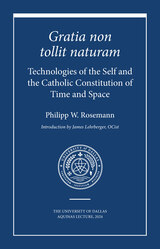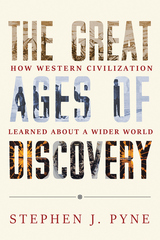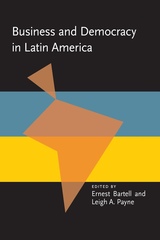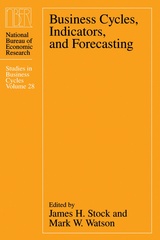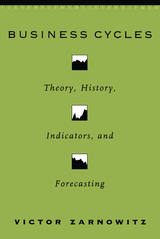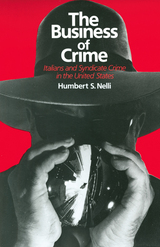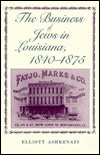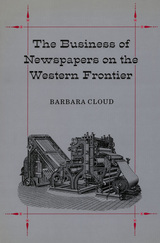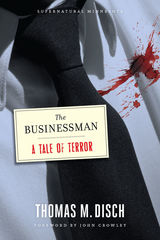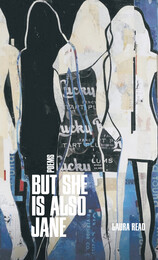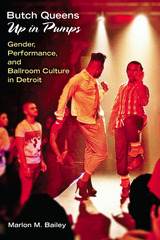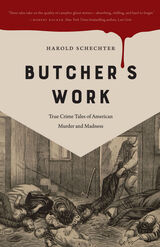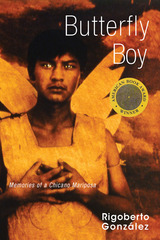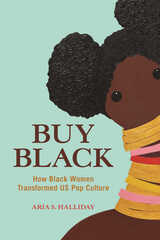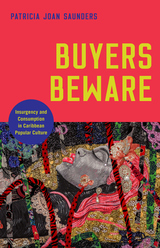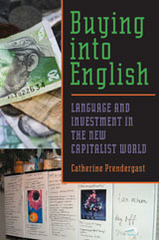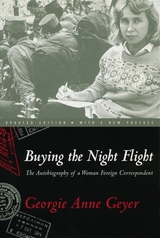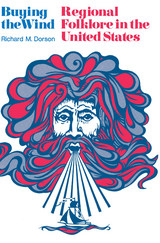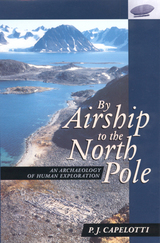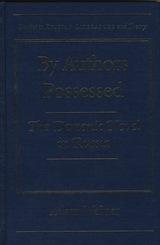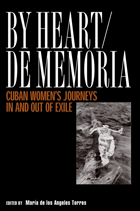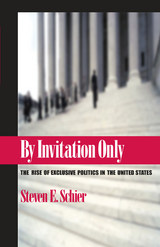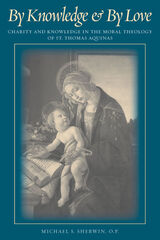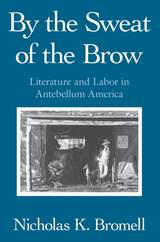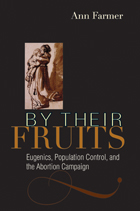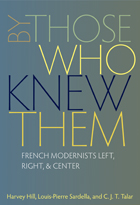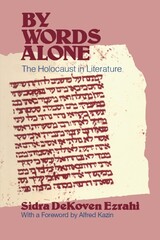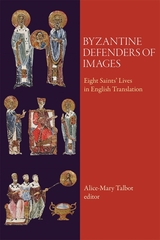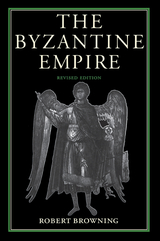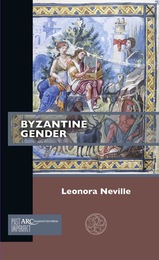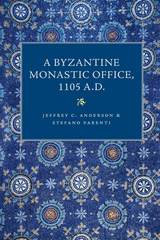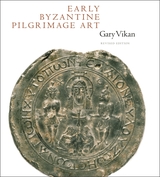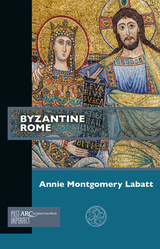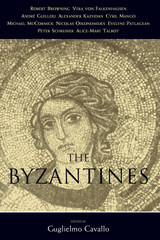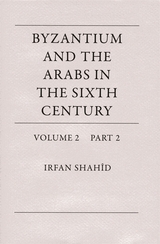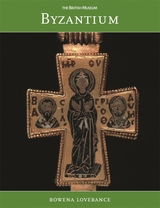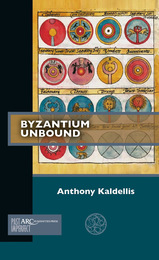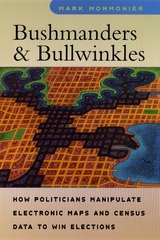 Bushmanders and Bullwinkles: How Politicians Manipulate Electronic Maps and Census Data to Win Elections
Mark Monmonier
University of Chicago Press, 2001 For years Mark Monmonier, "a prose stylist of no mean ability or charm" according to the Washington Post, has delighted readers with his insightful understanding of cartography as an art and technology that is both deceptive and revealing. Now he turns his focus to the story of political cartography and the redrawing of congressional districts. His title Bushmanders and Bullwinkles combines gerrymander with the surname of the president who actively tolerated racial gerrymandering and draws attention to the ridiculously shaped congressional districts that evoke the antlers of the moose who shared the cartoon spotlight with Rocky the Flying Squirrel.
Written from the perspective of a cartographer rather than a political scientist, Bushmanders and Bullwinkles examines the political tales maps tell when votes and power are at stake. Monmonier shows how redistricting committees carve out favorable election districts for themselves and their allies; how disgruntled politicians use shape to challenge alleged racial gerrymanders; and how geographic information systems can make reapportionment a controversial process with outrageous products. He also explores controversies over the proper roles of natural boundaries, media maps, census enumeration, and ethnic identity. Raising important questions about Supreme Court decisions in regulating redistricting, Monmonier asks if the focus on form rather than function may be little more than a distraction from larger issues like election reform.
Characterized by the same wit and clarity as Monmonier's previous books, Bushmanders and Bullwinkles is essential background for understanding what might prove the most contentious political debate of the new decade.
 The Business
Stephanie Lenox
University Press of Colorado, 2016 Published by the Center for Literary Publishing at Colorado State University
Winner of the 2015 Colorado Prize for Poetry
What does it mean to work in the age of the cubicle? The Business takes on the modern workplace with sharp-witted poems that sting like a paper cut. A former secretary, Stephanie Lenox positions herself as a poetic note-taker of the mundane. Organized by the classical components of Greek tragedy, these poems enact the relationships, heartbreaks, and small heroic efforts that make up our working lives. Think there's nothing poetic about annoying coworkers, endless meetings, and stained coffee mugs? Think again. While tragedy provides the organizational structure for this collection, humor plays a central role. This collection transforms office politics and paper clips into a funny and critical examination of the mortal rat race. If you've ever been fired, let go, unemployed, underemployed, or overlooked, these poems are for you. Begun on stolen reams of printer paper, this book reclaims the hours of our lives we give, out of necessity, to others in order to survive.
Business and Democracy in Latin America
Ernest Bartell
University of Pittsburgh Press, 1995 These essays provide the first published research on Latin America’s business sectors after recent political transformations in Argentina, Bolivia, Brazil, Mexico and Peru. They reveal the widely varied political and economic roles of business interests, particularly in regard to military regimes and the retreat of authoritarianism.
Business Arabic: A Comprehensive Vocabulary, Second Edition
Mai Zaki and John Mace
Georgetown University Press, 2021 An essential reference of contemporary Arabic terms for successful business communication Business Arabic: A Comprehensive Vocabulary contains the key terms professionals and learners need for successful business communication. Useful for translating both from Arabic to English and English to Arabic, this book is packed with more than 2,000 expressions and coinages commonly used in the workplace, including 700 new words for this edition and both American and British terms and spellings. Each thematically organized section includes an alphabetical list of the words and phrases you need to comprehend, translate, write, read, and speak modern business Arabic. Topics include data and communications, finance, insurance, law and contracts, research and production, publicity and marketing, and travel. Business Arabic also includes an English index for easy lookup.
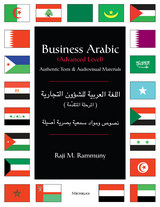 Business Arabic, Advanced Level: Authentic Texts and Audiovisual Materials
Raji M. Rammuny
University of Michigan Press, 2000 This second volume in the series Business Arabic is intended for high-intermediate and advanced learners. It contains seven units that cover a wide variety of authentic materials, including commercial advertisements, business correspondence, banking documents and transactions, economic reports, contracts, and agreements. The cultural notes throughout the lessons give the learner an in-depth view of the value systems of Arabs at work. This useful information affords learners insight into the way many Arabs feel about their work, and prepares them to deal effectively with the differences in values within the workplace.
Students who successfully complete the volume will be able to understand commercials and business reports presented orally in Arabic, read and comprehend original Arabic business documents; communicate effectively during business discussions and contract negotiations; successfully handle a broad variety of business forms and documents; and understand and deal effectively with social customs and behavior involved in business in the Arab world.
Raji M. Rammuny is Professor of Arabic Studies, Department of Near Eastern Studies, University of Michigan. He is the author of numerous books, including Advanced Standard Arabic through Authentic Texts and Audiovisual Materials, Parts 1 and 2, also published by the University of Michigan Press.
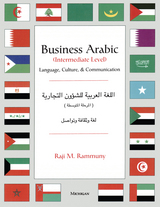 Business Arabic, Intermediate Level: Language, Culture and Communication
Raji M. Rammuny
University of Michigan Press, 2000 Raji M. Rammuny's Business Arabic, Intermediate Level is intended for intermediate learners who have completed at least two regular years of Arabic study. It contains twenty-one lessons, in addition to a general introduction that includes useful information on Arab countries. The lessons are arranged by situational topics pertinent to travel, social, and business interactions. Each lesson is supported by audio and video cassettes of about two to five minutes each. The set of dialogues employs a specific form of spoken standard Arabic that is flexible enough to be understood throughout the Arab world. Learners who successfully complete this part will be able to perform well in a variety of situations, both social and business. The cultural notes and questions for discussion in each lesson familiarize the learners with Arab social customs and prepare them to start examining one's own culture and that of the Arab world.
The volume expects students to have control of basic vocabulary and grammatical structures that are typically covered in the first two years of Arabic instruction. Grammatical notes are given for review purposes, where necessary.
 Business as Usual: How Sponsored Media Sold American Capitalism in the Twentieth Century
Caroline Jack
University of Chicago Press, 2024 How corporations used mass media to teach Americans that capitalism was natural and patriotic, exposing the porous line between propaganda and public service.
Business as Usual reveals how American capitalism has been promoted in the most ephemeral of materials: public service announcements, pamphlets, educational films, and games—what Caroline Jack calls “sponsored economic education media.” These items, which were funded by corporations and trade groups who aimed to “sell America to Americans,” found their way into communities, classrooms, and workplaces, and onto the airwaves, where they promoted ideals of “free enterprise” under the cloaks of public service and civic education. They offered an idealized vision of US industrial development as a source of patriotic optimism, framed business management imperatives as economic principles, and conflated the privileges granted to corporations by the law with foundational political rights held by individuals. This rhetoric remains dominant—a harbinger of the power of disinformation that so besets us today. Jack reveals the funding, production, and distribution that together entrenched a particular vision of corporate responsibility—and, in the process, shut out other hierarchies of value and common care.
 Business, Banking, and Politics: The Case of British Steel, 1918–1939
Steven Tolliday
Harvard University Press, 1987 During the 1920s, the "black decade" of British steel, nearly everyone agreed that the industry's revival depended on replacing obsolete equipment and instituting modern technologies that would increase production and decrease costs. Despite consensus, these goals were not reached and, even after wartime and postwar reconstruction needs were met, the industry continued its steady decline. Steven Tolliday advances three hypotheses for this stagnation.
First, the problems of British steel, Tolliday suggests, were embedded in the structures of individual firms and of the industry as a whole—both unchanged since the prosperous years of the nineteenth century—and after World War I fractured by conflicting interests (share holders, managers, family members, bankers, creditors). Second, the two external institutions that might have enforced reorganization and modernization—the banking system and the government—were overcautious, had complex and contradictory goals, and lacked the management skills to exploit their potential financial leverage. Third, the many attempts at reform by banks and government collapsed because these establishments, like the industry itself, were constrained by traditions and antiquated structural rigidities.
This excellent example of a new direction in business history—analysis of a given industry by conveying the interaction of technology, markets, companies, financial institutions, and government—brings many important theoretical questions into focus and also contributes substantially to the scrutiny of specific problems, such as why the British economy appears to be in irrevocable decline.
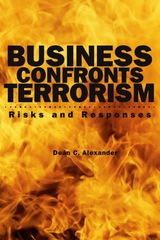 Business Confronts Terrorism: Risks and Responses
Dean C. Alexander
University of Wisconsin Press, 2004 Central banks and stock exchanges are bombed. Suicide bombers ravage cinemas, nightclubs, and theaters. Planes crash into skyscrapers and government buildings. Multiple bombs explode on commuter trains. Thousands of people are killed and injured while millions are terrorized by these attacks.
These scenarios could be part of a future Hollywood movie. Sadly, they are representative of previous terror attacks against industry and government interests worldwide. Moreover, they are harbingers of global terror threats.
Industry constitutes a prime target of contemporary terrorism. This timely book analyzes the threats companies face due to terrorism, industry responses to these dangers, and terrorism’s effects on conducting business in the post-9/11 environment. Dean C. Alexander details the conventional and unconventional terror capabilities facing industry. He describes the activities of terrorists in the economic system and the ways they finance their operations.
Alexander discusses how companies can reduce terrorist threats and that corporate security can minimize political violence. He outlines the dynamics of the public-private partnership against terrorism: government aiding industry, business supporting government, and tensions between the two. He also delineates terrorism’s effects—financial, physical, and emotional—on workers and employers. He highlights the negative financial and economic consequences of terrorism. He discusses the impact of terrorism on traditional business practices and concludes with an assessment of future trends.
Business Cycles, Indicators, and Forecasting
Edited by James H. Stock and Mark W. Watson
University of Chicago Press, 1993 The inability of forecasters to predict accurately the 1990-1991 recession emphasizes the need for better ways for charting the course of the economy. In this volume, leading economists examine forecasting techniques developed over the past ten years, compare their performance to traditional econometric models, and discuss new methods for forecasting and time series analysis.
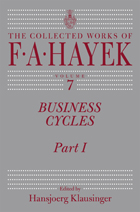 Business Cycles: Part I
F. A. Hayek
University of Chicago Press, 2012 In the years following its publication, F. A. Hayek’s pioneering work on business cycles was regarded as an important challenge to what was later known as Keynesian macroeconomics. Today, as debates rage on over the monetary origins of the current economic and financial crisis, economists are once again paying heed to Hayek’s thoughts on the repercussions of excessive central bank interventions. The latest editions in the University of Chicago Press’s ongoing series The Collected Works of F. A. Hayek, these volumes bring together Hayek’s work on what causes periods of boom and bust in the economy. Moving away from the classical emphasis on equilibrium, Hayek demonstrates that business cycles are generated by the adaptation of the structure of production to changes in relative demand. Thus, when central banks artificially lower interest rates, the result is a misallocation of capital and the creation of asset bubbles and additional instability. Business Cycles, Part I contains Hayek’s two major monographs on the topic: Monetary Theory and the Trade Cycle and Prices and Production. Reproducing the text of the original 1933 translation of the former, this edition also draws on the original German, as well as more recent translations. For Prices and Production, a variorum edition is presented, incorporating the 1931 first edition and its 1935 revision. Business Cycles, Part II assembles a series of Hayek’s shorter papers on the topic, ranging from the 1920s to 1981. In addition to bringing together Hayek’s work on the evolution of business cycles, the two volumes of Business Cycles also include extensive introductions by Hansjoerg Klausinger, placing the writings in intellectual context—including their reception and the theoretical debates to which they contributed—and providing background on the evolution of Hayek’s thought.
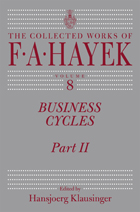 Business Cycles: Part II
F. A. Hayek
University of Chicago Press, 2012 In the years following its publication, F. A. Hayek’s pioneering work on business cycles was regarded as an important challenge to what was later known as Keynesian macroeconomics. Today, as debates rage on over the monetary origins of the current economic and financial crisis, economists are once again paying heed to Hayek’s thoughts on the repercussions of excessive central bank interventions. The latest editions in the University of Chicago Press’s ongoing series The Collected Works of F. A. Hayek, these volumes bring together Hayek’s work on what causes periods of boom and bust in the economy. Moving away from the classical emphasis on equilibrium, Hayek demonstrates that business cycles are generated by the adaptation of the structure of production to changes in relative demand. Thus, when central banks artificially lower interest rates, the result is a misallocation of capital and the creation of asset bubbles and additional instability. Business Cycles, Part I contains Hayek’s two major monographs on the topic: Monetary Theory and the Trade Cycle and Prices and Production. Reproducing the text of the original 1933 translation of the former, this edition also draws on the original German, as well as more recent translations. For Prices and Production, a variorum edition is presented, incorporating the 1931 first edition and its 1935 revision. Business Cycles, Part II assembles a series of Hayek’s shorter papers on the topic, ranging from the 1920s to 1981. In addition to bringing together Hayek’s work on the evolution of business cycles, the two volumes of Business Cycles also include extensive introductions by Hansjoerg Klausinger, placing the writings in intellectual context—including their reception and the theoretical debates to which they contributed—and providing background on the evolution of Hayek’s thought.
Business Cycles: Theory, History, Indicators, and Forecasting
Victor Zarnowitz
University of Chicago Press, 1992 This volume presents the most complete collection available of the work of Victor Zarnowitz, a leader in the study of business cycles, growth, inflation, and forecasting..
With characteristic insight, Zarnowitz examines theories of the business cycle, including Keynesian and monetary theories and more recent rational expectation and real business cycle theories. He also measures trends and cycles in economic activity; evaluates the performance of leading indicators and their composite measures; surveys forecasting tools and performance of business and academic economists; discusses historical changes in the nature and sources of business cycles; and analyzes how successfully forecasting firms and economists predict such key economic variables as interest rates and inflation.
 Business Ethics and Catholic Social Thought
Daniel K. Finn, Editor
Georgetown University Press, 2023 A comprehensive overview of the contribution of Catholic social thought to business ethics Can a religion founded on loving one’s neighbor give moral approval to profit-seeking business firms in a global economy? What should characterize the relationship between faith and economic life? What can businesses, employees, and executives do to contribute to the common good and to make their practices and society more ethical? Business Ethics and Catholic Social Thought provides a new and wide-ranging account of these two ostensibly divergent fields. Focusing on the agency of the business person and the interests of firms, this volume outlines fundamental issues confronting moral leaders and corporations committed to responsible business practices. The book leads with interviews of three Catholic CEOs and the intellectual history of business ethics in Christianity before examining fundamental moral concerns regarding business: its purpose, autonomy, practical wisdom, and the technocratic paradigm. Contributing authors also consider management science, the motivations of business leaders, the role of luck in personal success, the traditional moral justifications for business, and more. These contributions bring new depth to the application of Catholic social thought to business ethics during a time when economic crisis demands a reevaluation of business and its contribution to society.
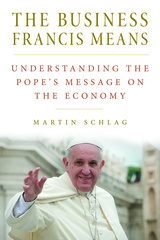 The Business Francis Means: Understanding the Pope's Message on the Economy
Martin Schlag
Catholic University of America Press, 2017 Pope Francis, generally speaking, has thus far chosen to concentrate his papacy on social justice issues, as opposed to doctrinal or liturgical issues. This has led to Francis being hailed as a hero to many on the left, while it has made some conservative supporters of St. John Paul II and Pope Emeritus Benedict XVI disappointed and uncomfortable, even as they love and appreciate his person and gestures of mercy and compassion. Some find his teachings difficult to embrace, especially those concerning business and the economy. Pope Francis has spoken of building bridges as part of what it is to be Christian, but aspects of his message seem to be just constructing walls between the Holy Father and groups of the faithful.
The Business Francis Means aims to break through these walls, showing that Pope Francis has something to say to all Christians. His message, taken as a whole, keeps us from dividing the “seamless garment” of Christ: he reminds the conservatives of the problems of inequality and poverty, and the liberals that social justice is not enough – the Church is the bride of Christ, not a social institution or an NGO.
Monsignor Martin Schlag summarizes and explains the message of Pope Francis on business and the economy in this compact volume. The Business Francis Means will be of great interest to the Catholic layperson, especially one involved in political or economic life.
 Business Japanese
Shoji Azuma and Ryo Sambongi
Georgetown University Press, 2001 Written for intermediate to advanced students of Japanese, this book focuses on the language used in real-life business situations, giving students both the linguistic skills and the practical information they need to conduct business in Japan. More than a guide to language and vocabulary, Business Japanese emphasizes critical thinking and cultural awareness. The book covers Internet and other technical terminology, numbers, and the phrasing of corporate documents. In addition to language elements, the authors provide a short course in the cultural learning that takes place when Americans do business in Japan, discussing topics such as interpersonal dynamics and communications styles. The book also uses the case-study method commonly accepted in business schools. Appropriate for content-based courses as well as the independent student, Business Japanese is not only an effective language text but also an intercultural handbook.
 The Business of America: The Cultural Production of a Post-War Nation
Graham Thompson
Pluto Press, 2004 The Business of America examines the complex linking of business and nationhood in post-war United States literature against the backdrop of changing concepts of the nation in the field of American Studies.
The first part of the book examines how white male literary culture has been largely hostile to business during this period and how it has represented transnational shifts in the nature of business as threats to supposedly American values like the individual, the family, or freedom. The book charts the way that such an uneasiness towards business relies upon a discourse about America, business and empire that is increasingly untenable in the post-war world.
By way of comparison, The Business of America looks at how literature by women and by writers from different racial, ethnic and sexual groups often deals with business from the more localised angle of work. Graham Thompson shows how this attention to work provides a less abstract and more oppositional approach to the connection between business and America.
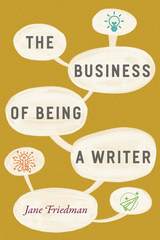 The Business of Being a Writer
Jane Friedman
University of Chicago Press, 2018 Writers talk about their work in many ways: as an art, as a calling, as a lifestyle. Too often missing from these conversations is the fact that writing is also a business. The reality is, those who want to make a full- or part-time job out of writing are going to have a more positive and productive career if they understand the basic business principles underlying the industry.
The Business of Being a Writer offers the business education writers need but so rarely receive. It is meant for early-career writers looking to develop a realistic set of expectations about making money from their work or for working writers who want a better understanding of the industry. Writers will gain a comprehensive picture of how the publishing world works—from queries and agents to blogging and advertising—and will learn how they can best position themselves for success over the long term.
Jane Friedman has more than twenty years of experience in the publishing industry, with an emphasis on digital media strategy for authors and publishers. She is encouraging without sugarcoating, blending years of research with practical advice that will help writers market themselves and maximize their writing-related income. It will leave them empowered, confident, and ready to turn their craft into a career.
 The Business of Being a Writer, Second Edition
Jane Friedman
University of Chicago Press, 2025 A thoroughly revised edition of the comprehensive guide to building and maintaining a successful career in writing.
Writers talk about their work in many ways: as an art, as a calling, as a lifestyle. Too often missing from these conversations is the fact that writing is also a business, and those who want to make a living from their writing must understand the basic business principles underlying the industry. The Business of Being a Writer offers the business education writers need but so rarely receive.
Jane Friedman is one of today’s leading experts on the publishing industry. Through her website, social media presence, online courses, email newsletters, and other media, she helps writers understand how to navigate the industry with confidence and intentionality. This book advises writers on how to build a platform in a way that aligns with their values, how to spot critical mindset issues that might sabotage their efforts before they even begin, how to publish strategically, and what it means to diversify income streams beyond book sales. For this second edition, Friedman has updated every topic to reflect how the industry has evolved over the past half decade. New features include a section on business and legal issues commonly faced by writers, exercises at the end of each chapter, and a wealth of sample materials posted on a companion website.
Reaching beyond the mechanical aspects of publishing, The Business of Being a Writer will help both new and experienced writers approach their careers with the same creative spirit as their writing. Friedman is encouraging without sugarcoating reality, blending years of research with practical advice that will help writers market themselves and maximize their writing-related income. Her book will leave them empowered, confident, and ready to turn their craft into a sustainable career.
 The Business of Charity: The Woman's Exchange Movement, 1832-1900
Kathleen Waters Sander
University of Illinois Press, 1998 In the nineteenth century, Woman's Exchanges formed a vast national network that created economic alternatives for financially vulnerable women in a world that permitted few respectable employment options. Many remain in business. Kathleen Waters Sander delves into the history of Woman's Exchanges and looks at the women who led the organizations—and those who used them to stave off poverty. One of the nation's oldest continuously operating voluntary movements, Exchanges like the Philadelphia Ladies' Depository and the Dorcas Society were fashionable, popular shops where women who had fallen on hard times could sustain themselves. By selling their handiwork on consignment, they not only earned money but avoided the stigma of seeking public employment. As Sander shows, Exchanges evolved into an important forum for entrepreneurial growth. They also provide an example of how women used the voluntary sector, which had so successfully served as a conduit for their political and social reforms, to advance opportunities for economic independence.
The Business of Crime: Italians and Syndicate Crime in the United States
Humbert S. Nelli
University of Chicago Press, 1981 "Dr. Nelli . . . describes the kinds of crime that prevailed in Italian immigrant enclaves in America; like most American crime, then as now, Italian crime was one aspect of the so-called culture of urban poverty—boys graduated from street gangs to criminal gangs. None of these gangs were very big until Prohibition brought the Great Leap Forward, to a level that Dr. Nelli calls 'entrepreneurial crime.' His fine account makes sense of many murderous incidents, differentiates among places, and sketches individuals and the talents (Torrio's brains, Capone's brutality) that enabled them to rise in the underworld."—New Yorker
"A definitive history of organized crime in America."—American Historical Review
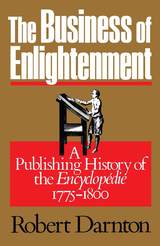 The Business of Enlightenment: A Publishing History of the Encyclopédie, 1775–1800
Robert Darnton
Harvard University Press, 1979 ”A major achievement of American scholarship and in the first rank of those which have been transforming our view of French history during the last twenty years.“ —New York Review of Books
A great book about an even greater book is a rare event in publishing. Robert Darnton’s history of the Encyclopédie is such an occasion. The author explores some fascinating territory in the French genre of histoire du livre, and at the same time he tracks the diffusion of Enlightenment ideas. He is concerned with the form of the thought of the great philosophes as it materialized into books and with the way books were made and distributed in the business of publishing. This is cultural history on a broad scale, a history of the process of civilization.
In tracing the publishing story of Diderot’s Encyclopédie, Darnton uses new sources—the papers of eighteenth-century publishers—that allow him to respond firmly to a set of problems long vexing historians. He shows how the material basis of literature and the technology of its production affected the substance and diffusion of ideas. He fully explores the workings of the literary market place, including the roles of publishers, book dealers, traveling salesmen, and other intermediaries in cultural communication. How publishing functioned as a business, and how it fit into the political as well as the economic systems of prerevolutionary Europe are set forth. The making of books touched on this vast range of activities because books were products of artisanal labor, objects of economic exchange, vehicles of ideas, and elements in political and religious conflict.
The ways ideas traveled in early modern Europe, the level of penetration of Enlightenment ideas in the society of the Old Regime, and the connections between the Enlightenment and the French Revolution are brilliantly treated by Darnton. In doing so he unearths a double paradox. It was the upper orders in society rather than the industrial bourgeoisie or the lower classes that first shook off archaic beliefs and took up Enlightenment ideas. And the state, which initially had suppressed those ideas, ultimately came to favor them. Yet at this high point in the diffusion and legitimation of the Enlightenment, the French Revolution erupted, destroying the social and political order in which the Enlightenment had flourished.
Never again will the contours of the Enlightenment be drawn without reference to this work. Darnton has written an indispensable book for historians of modern Europe.
Business Of Jews In Louisiana, 1840–1875
Elliot Ashkenazi
University of Alabama Press, 1988 Goes beyond institutional history to concentrate on commercial and social matters
The author’s findings imply that Jewish immigrants to the South in the first half of the 19th century came from particular locales with similar social, economic, and religious backgrounds, and they chose to live in the South because of those traditions. The experience of Jews with commercial capitalism, rather than landowning, in agricultural societies, gave the Jews of Louisiana a comparable niche in America, and they participated in the commercial aspects of a regional economy based on agricultural production. Commercial and family connections with other Jewish groups facilitated their development into a settled community. In growth and decline, Jewish communities in Louisiana and elsewhere became permanent features of the landscape and influenced, and were influenced, by the areas in which they lived.
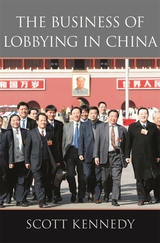 The Business of Lobbying in China
Scott Kennedy
Harvard University Press, 2005 In this timely work, Scott Kennedy documents the rising influence of business, both Chinese and foreign, on national public policy in China.
China's shift to a market economy has made businesses more sensitive to their bottom line and has seen the passage of thousands of laws and regulations that directly affect firms' success. Companies have become involved in a tug of war with the government and with each other to gain national policy advantages, often setting the agenda, providing alternative options, and pressing for a favored outcome.
Kennedy's comparison of lobbying in the steel, consumer electronics, and software industries shows that although companies operate in a common political system, economic circumstances shape the nature and outcome of lobbying. Factors such as private or state ownership, size, industry concentration, and technological sophistication all affect industry activism.
Based on over 300 in-depth interviews with company executives, business association representatives, and government officials, this study identifies a wide range of national economic policies influenced by lobbying, including taxes, technical standards, and intellectual property rights. These findings have significant implications for how we think about Chinese politics and economics, as well as government-business relations in general.
 The Business of Private Medical Practice: Doctors, Specialization, and Urban Change in Philadelphia, 1900-1940
James A. Schafer Jr.
Rutgers University Press, 2013 Unevenly distributed resources and rising costs have become enduring problems in the American health care system. Health care is more expensive in the United States than in other wealthy nations, and access varies significantly across space and social classes. James A. Schafer Jr. shows that these problems are not inevitable features of modern medicine, but instead reflect the informal organization of health care in a free market system in which profit and demand, rather than social welfare and public health needs, direct the distribution and cost of crucial resources.
The Business of Private Medical Practice is a case study of how market forces influenced the office locations and career paths of doctors in one early twentieth-century city, Philadelphia, the birthplace of American medicine. Without financial incentives to locate in poor neighborhoods, Philadelphia doctors instead clustered in central business districts and wealthy suburbs. In order to differentiate their services in a competitive marketplace, they also began to limit their practices to particular specialties, thereby further restricting access to primary care. Such trends worsened with ongoing urbanization.
Illustrated with numerous maps of the Philadelphia neighborhoods he studies, Schafer’s work helps underscore the role of economic self-interest in shaping the geography of private medical practice and the growth of medical specialization in the United States.
 The Business of Professional Sports
Edited by Paul D. Staudohar and James A. Mangan
University of Illinois Press, 1991 Beyond the highly publicized heroics and foibles of players and teams, when the grandstands are empty and the scoreboards dark, there is a world of sport about which little is known by even the most ardent fan. It is the business world of sport; it is characterized by a thirst for power and money, and its players are just as active as those on the professional teams they oversee. In this collection, some of the best scholars in the field use examples from baseball, football, basketball, and hockey to illuminate the significant economic, legal, social, and historic aspects of the business of professional sports. Contributors: Dennis A. Ahlburg, Rob B. Beamish, Joan M. Chandler, James B. Dworkin, Lawrence M. Kahn, Charles P. Korr, John J. MacAloon, David Mills, Roger G. Noll, Steven A. Reiss, Gary R. Roberts, Stephen F. Ross, Peter D. Sherer, Leigh Steinberg, and David G. Voigt,
 The Business of Racism: Labor and Environment in Brazil's Racial Capitalism
Ian Carrillo
Duke University Press, 2026 In The Business of Racism, Ian Carrillo employs a case study from Brazil’s sugarcane industry to show how racial capitalism is promulgated and maintained through politics and business. As Carrillo recounts, in the mid-2000s, Brazil embarked on a state-led project to improve environmental and labor conditions in sugarcane production. He describes how, seeing increased government regulation of their worksite as a threat to their power, the elites of Brazil’s sugar-ethanol industry repurposed long-standing racial ideologies to undermine progressive institutions and elevate their own leaders. Carrillo’s extensive ethnographic fieldwork in mills and plantations, as well as interviews with federal labor regulators and sugar-ethanol industry elites in Brazil, weaves together an account of how Brazil’s labor and environmental regulations are forged through racial and class struggles at worksites and within the state. The Business of Racism contributes to ongoing sociological debates about race, development, and the environment while highlighting future pathways for achieving racial justice, labor equality, and climate sustainability.
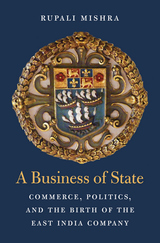 A Business of State: Commerce, Politics, and the Birth of the East India Company
Rupali Mishra
Harvard University Press, 2018 At the height of its power around 1800, the English East India Company controlled half of the world’s trade and deployed a vast network of political influencers at home and abroad. Yet the story of the Company’s beginnings in the early seventeenth century has remained largely untold. Rupali Mishra’s account of the East India Company’s formative years sheds new light on one of the most powerful corporations in the history of the world.
From its birth in 1600, the East India Company lay at the heart of English political and economic life. The Company’s fortunes were determined by the leading figures of the Stuart era, from the monarch and his privy counselors to an extended cast of eminent courtiers and powerful merchants. Drawing on a host of overlooked and underutilized sources, Mishra reconstructs the inner life of the Company, laying bare the era’s fierce struggles to define the difference between public and private interests and the use and abuse of power. Unlike traditional accounts, which portray the Company as a private entity that came to assume the powers of a state, Mishra’s history makes clear that, from its inception, the East India Company was embedded within—and inseparable from—the state.
A Business of State illuminates how the East India Company quickly came to inhabit such a unique role in England’s commercial and political ambitions. It also offers critical insights into the rise of the early modern English state and the expansion and development of its nascent empire.
 The Business of Sustainable Forestry: Strategies For An Industry In Transition
Michael B. Jenkins and Emily T. Smith; Foreword by Jonathan Lash Stephan Schmidheiny
Island Press, 1999 A range of powerful forces -- increasing demand for wood, uncertain and decreasing supply, increasing environmental pressures, and growing markets for environmentally certified wood -- are changing the way the forest products industry conducts business. Forward-thinking firms have recognized the significance of these forces and are developing a new business model, one that will not only sustain revenues, but can ensure the long-term health of the forests upon which the industry depends.The Business of Sustainable Forestry integrates and analyzes a series of 21 case studies of industry leaders carried out by the Sustainable Forestry Working Group. The motivations of the pioneering firms studied are as varied as their characteristics, yet each has made significant progress. The authors of this book argue that the operations that have been most succeessful are those that have integrated sustainable forestry principles and practices into their overall corporate strategy. The book: describes the forces that are pushing the industry toward sustainability presents an overview of the new techniques and technologies that are making sustainable forestry more feasible than ever presents in clear, engaging prose company profiles that demonstrate both the promise of and the obstacles to sustainable forest management gives a clear-eyed look at practices such as certification and their capacity to transform the forest products market provides conclusions drawn from the cases by Stuart Hart of the University of North Carolina and Matt Arnold of the Management Institute for Environment and Business offers a succinct set of lessons learned The Business of Sustainable Forestry is the first book to present a composite snapshot of the business of sustainable forestry and the lessons learned by early adopters in form and language accessible to the general business reader. Forest and natural resource managers, forest products industry managers, and students and academics in schools of business and forestry will find the book a unique and valuable guide to an industry in transition.
 Business Plans for Filmmakers
John W. Cones
Southern Illinois University Press, 2010 The practical and legal aspects of writing a business plan for a film venture can be daunting to navigate without a firm grasp of know-how. With this in mind, John W. Cones's Business Plans for Filmmakers arms independent movie-makers and students with everything they need to successfully tackle the confusing intersection of law, business, and art when creating a business plan for a movie. This pragmatic volume offers plenty of examples and strategies for success, sharing straightforward insight into some of the toughest challenges independent filmmakers face when encountering these documents.
With simple yet thorough detail and clarity, Cones outlines the legal requirements affecting movie proposals, including ways to evaluate the necessity for a business plan or a securities disclosure document, as well as the legal definition of "an active investor." Also addressed are the numerous subjects filmmakers and students must consider before a film offering, including the efficacy of a business plan to fund the development, production, and distribution phases of a film; common elements of fraud of which fledgling filmmakers should beware; the intricacies of revenue sharing; and how to render financial projections. Cones also imparts useful distinctions between such industry terms as "company financing" versus "project financing," along with many others.
This bookalso includes in-depth guidance through the murky paths of investor analysis and key strategies to find and attract parties interested in financing film. Drawing upon his many years as a securities and entertainment attorney, and his experiences advising independent film producers, Cones offers the tools necessary not only to understand investors' motivations but also to use that knowledge to the filmmaker's advantage. Also provided are perceptive studies of the investment vehicles commonly used in business plans seeking investors, with analysis of each method's pros and cons. Throughout the volume, Cones uses sample plans to offer a real-world grasp of the intricacies of the business.
In the business of this art, knowledge is power. Business Plans for Filmmakers dispels the myths and misinformation circulating among filmmakers to provide accurate and useful advice.
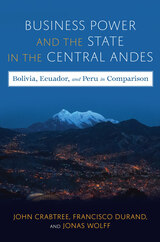 Business Power and the State in the Central Andes: Bolivia, Ecuador, and Peru in Comparison
John Crabtree
University of Pittsburgh Press, 2023 Offers Fresh Insight into Crucial Debates over the Causes of Diverging and Converging Political Trajectories in the Region
This coauthored monograph examines how business groups have interacted with state authorities in the three central Andean countries from the mid-twentieth century through the early twenty-first. This time span covers three distinct economic regimes: the period of state-led import substitutive industrialization from the 1950s through the 1970s, the neoliberalism of the 1980s and 1990s, and the post-neoliberal period since the earlier 2000s. These three countries share many similarities but also have important differences that reveal how power is manifested. Peru has had an almost unbroken hegemony of business elites who leverage their power over areas of state activity that affect them. Bolivia, by contrast, shows how strong social movements have challenged business dominance at crucial periods, reflecting a weaker elite class that is less able to exercise influence over decision-making. Ecuador falls in between these two, with business elites being more fragmented than in Peru and social movements being weaker than in Bolivia. The authors analyze the viability of these different regimes and economic models, why they change in specific circumstances, and how they affect the state and its citizen
 Business Religion Spirituality
Oliver F. Williams
University of Notre Dame Press, 2003 The new emphasis on spirituality in the workplace has been widely discussed in recent years and reported in major publications such as the Wall Street Journal and Fortune. Spirituality seems to be a basic human good essential for human flourishing. The contributors to this volume are all proponents of spirituality in the workplace, yet all raise important questions about this movement and what it means. What are the moral questions that should guide leaders? Is spirituality being treated as simply an instrumental good, valued for its usefulness in enhancing productivity and well-being? What are the responsibilities of business leaders? Of business schools and their faculty? Of churches? The essayists in this collection reflect on these and other pertinent questions.
The common thread linking these authors is that all have distinguished themselves in their respective fields or professions and all wish to advance spirituality in business. Contributors to Business, Religion, and Spirituality provide a sober, but positive, prognosis for this new growth in spirituality while offering direction for the future.
----------
OLIVER F. WILLIAMS, C.S.C., is associate professor of management in the Mendoza School of Business and director of the Center for Ethics and Religious Values in Business at the University of Notre Dame. He also serves as the Donald Gordon Fellow and Visiting Professor in a joint appointment at the University of Cape Town and Stellenbosch University in Cape Town, South Africa.
----------
"This collection connects business and the spiritual life by casting a wide net of awareness and responsibility. These writers testify that beyond the networks of workplace relationships are people touched over great distances by daily business decisions and the structures within which they take place. Drawing on multiple faith persectives, these essays press conscience toward the intersection of personal and social responsibility. They are marked by a constructive and humble spirit that may one day inspire an understanding of vocation appropriate to a new century of global interdependence." --David J. O'Brien, Loyola Professor of Roman Catholic Studies, College of the Holy Cross
"Business, Religion, and Spirituality makes an important contribution by pulling together a great deal of material and giving it a fresh twist. It raises significant questions and issues and features essays by some of the most respected and visible scholars and practioners in the field." --Thomas A. Bausch, Marquette University
"…a collection of thoughtful and thought-provoking essays by diverse learned authors concerning the meeting point between commercial workplace responsibility and personal spiritual values." --Midwest Book Review
"Recommended. General readers, undergraduates, and professionals." --Choice
 Business Without Boundary: The Story of General Mills
James Gray
University of Minnesota Press, 1954 Business Without Boundary was first published in 1954. Minnesota Archive Editions uses digital technology to make long-unavailable books once again accessible, and are published unaltered from the original University of Minnesota Press editions. The firm of General Mills is probably best known to millions of people as the maker of Gold Medal Flour and as the progenitor of that first lady of the kitchen and the airwaves, Betty Crocker. But, although its greatest fame is as a flour miller, the company engages in a host of other activities that attest to the foresight and creative thinking of its executives. In fact, the sky seems to be the only limit as the company extends its sights upward in Operation Skyhook, a United States navy research project for which General Mills makes and launches into the stratosphere giant plastic balloons. James Gray relates not only the history of General Mills since its founding in 1928 but also the background of the major companies that merged to form the larger corporation: the Washburn Crosby Company of Minneapolis, the Sperry Company of San Francisco, the Kell group of Texas and Oklahoma mills, and the Larrowe Milling Company of Detroit. Anyone interested in advertising and promotion will find fascinating the accounts of the early successes in radio advertising, including the first use of singing commercials and the phenomenal rise of Betty Crocker (voted the second best-known woman in America!) The scientific and technical research that is a cornerstone of the modern corporation is described in detail, as is the development of the products control method, a General Mills innovation now widely adopted in industry. For those curious to understand how business expands, for those interested in a close-up of industrial leaders, for anyone who wants to sharpen his view of America at work, this is an important book.
The Businessman: A Tale of Terror
Thomas M. Disch
University of Minnesota Press, 2010
The Businessman presents the sinister tale of Bob Glandier, a morally repulsive Twin Cities executive who murders his estranged wife and attempts to go back to business as usual, until she returns sets about arranging his divine retribution. With help from her dead mother and the ghost of poet John Berryman-thoroughly bored of suburban séances and all too eager to lend a hand-Giselle undertakes the elaborate, righteous, and wickedly amusing haunting of her husband. There is justice in the afterlife after all-at least in Minnesota.
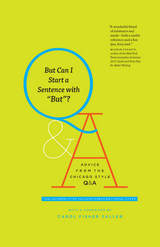 But Can I Start a Sentence with "But"?: Advice from the Chicago Style Q&A
The University of Chicago Press Editorial Staff
University of Chicago Press, 2016 Q. Is it “happy medium” or “happy median”? My author writes: “We would all be much better served as stewards of finite public funds if we could find that happy median where trust reigns supreme.” Thanks!
A. The idiom is “happy medium,” but I like the image of commuters taking refuge from road rage on the happy median.
Q. How do I write a title of a song in the body of the work (caps, bold, underline, italics, etc.)? Example: The Zombies’ “She’s Not There” looped in his head.
A. Noooo! Now that song is looping in my head (“but it’s too late to say you’re sorry . . .”). Use quotation marks. Thanks a lot. Every month, tens of thousands of self-declared word nerds converge upon a single site: The Chicago Manual of Style Online's Q&A. There the Manual’s editors open the mailbag and tackle readers’ questions on topics ranging from abbreviation to word division to how to reform that coworker who still insists on two spaces between sentences. Champions of common sense, the editors offer smart, direct, and occasionally tongue-in-cheek responses that have guided writers and settled arguments for more than fifteen years. But Can I Start a Sentence with “But”? brings together the best of the Chicago Style Q&A . Curated from years of entries, it features some of the most popular—and hotly debated—rulings and also recovers old favorites long buried in the archives. Questions touch on myriad matters of editorial style—capitalization, punctuation, alphabetizing, special characters—as well as grammar, usage, and beyond (“How do I spell out the sound of a scream?”). A foreword by Carol Fisher Saller, the Q&A’s longtime editor, takes readers through the history of the Q&A and addresses its reputation for mischief. (“It’s not that we set out to be cheeky,” she writes.) Taken together, the questions and answers offer insights into some of the most common issues that face anyone who works with words. They’re also a comforting reminder that even the best writer or editor needs a little help—and humor—sometimes.
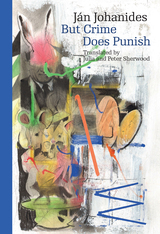 But Crime Does Punish
Ján Johanides
Karolinum Press, 2022 A haunting novel of post-Soviet Slovakia, centering on an enigmatic one-sided conversation.
“So, as you see, I am familiar with the case. However, we can’t discuss it unless you learn more about some other court cases, so that you can compare your father’s trial with other, more baffling cases, and see it in the context of the madness that reigned at the time.”
Ján Johanides’ riveting Slovak novel immediately thrusts you into the midst of a bewildering second-person dialogue, bestowing the reader with the role of a silent partner in a one-sided conversation with a mysterious archivist. As the story unfurls piece by piece, it becomes clear that the archivist, who can’t seem to stay on topic, has both a tragic history and the key to unlocking your family’s darkest secret, a secret that may or may not involve the Czechoslovak secret police, American and Soviet intelligence, Israeli politics, and a tire full of dollars.
Set after the fall of the Soviet Union and the dissolution of Czechoslovakia, But Crimes Do Punish is awash with paranoia, revealing how the madness of the Communist era continues to bleed into the instability of the present. Written in 1995, this haunting novel—the first work of Slovak fiction published by Karolinum Press—evokes the spirit of John le Carré and the style of Carlos Fuentes while illuminating issues that still plague post-Communist Europe.
 But Is It True?: A Citizen’s Guide to Environmental Health and Safety Issues
Aaron Wildavsky
Harvard University Press, 1995 We've eaten Alar with our apples and PCBs with our fish, drunk arsenic with our water, breathed asbestos in our schools. Someone sounded the alarm, someone else said we were safe, and both had science on their side. Whom are we to trust? How are we to know? Amid this chaos of questions and conflicting information, Aaron Wildavsky arrives with just what the beleaguered citizen needs: a clear, fair, and factual look at how the rival claims of environmentalists and industrialists work, what they mean, and where to start sorting them out.
Working with his students at a risk analysis center, Wildavsky examined all the evidence behind the charges and countercharges in several controversial cases involving environmental health and public safety. Here he lays out these cases in terms an average citizen can understand, weighs the merits of the claims of various parties, and offers reasoned judgments on the government's response. From Love Canal to Times Beach, from DDT to Agent Orange, acid rain, and global warming, from saccharin to asbestos, nuclear waste, and radon, Wildavsky shows how we can achieve an informed understanding of the contentious environmental issues that confront us daily. The book supports the conclusion Wildavsky reached himself, both as a citizen committed to the welfare of the earth and its inhabitants, and as a social scientist concerned with how public policy is made: though it is bad to be harmed, it is worse to be harmed in the name of health.
But She Is Also Jane
Laura Read
University of Massachusetts Press, 2023 Conversational, irreverent, and disarmingly honest, the poems of But She Is Also Jane follow the everyday contours of women’s lives and the expectations they grapple with. As our speaker approaches middle age, she copes with the loss of loved ones, the realities of an emptying nest, the routine indignities of sexism, and nostalgia for the past. Laura Read’s third poetry collection balances discussions of Degas, Vermeer, and Marie Curie with reflections on Sammy Hagar, a troubling outing to a male revue, and memories of watching Mork and Mindy on the night of her mother’s hysterectomy.
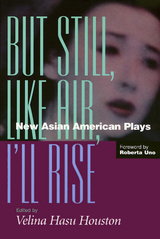 But Still Like Air
edited by Velina Hasu Houston, foreword by Roberta Uno
Temple University Press, 1997 In this pathbreaking volume, Velina Hasu Houston gathers together eleven plays that speak in the "hybridized, unique American voices of Asian descent -- and often dissent." These writers resist the bigotry that attempts to target them solely as people of color as well as the homogenizing tendencies of a multiculturalism that fails to recognize the varied make-up of Asian America. Anthologized for the first time, these plays testify to the rich complexity of Asian American experience while they also demonstrate the different styles and thematic concerns of the individual playwrights.
What are Asian American plays about? Family conflicts, sexuality, social upheaval, betrayal ... the stuff of all drama. Whether the characters are a middle-aged Taiwanese woman who is married to an Irish American and who dreams of opening a Chinese restaurant, a Chinese American female bond trader trying to survive a corporate takeover, or an ABC (American Born Chinese) gay man whose lover has AIDS, their Asian-ness is only a part of their story.
As a playwright, Houston is keenly aware of the rigid formulas that often exclude writers of color and women women writers from mainstream theater. But Still, Like air, I'll Rise brings forth vibrant new work that challenges producers and audiences to broaden their expectations, to attend to the unfamiliar voices that expresses the universal and particular vision of Asian American playwrights.
Butch Geography
Stacey Waite
Tupelo Press, 2013 In her Los Angeles Review of Books essay “Who Is Who: Pronouns, Gender, and Merging Selves,” Dana Levin describes Stacey Waite’s fusion of gender identities: “Pseudonyms, heteronyms, personae, all the ventriloquizing literary arts; point of view and tonal shifts: these are tools for speakers and speaking. But the sentence too has a voice: ‘i will not be the kind of boy who can not bear the memory of her body’ … This is [Waite’s] genius … to take innocuous syntactical phrasing and change the players mid-sentence — to get around English’s pronominal either/or by creating a syntactical both/and…”
Butch Queens Up in Pumps: Gender, Performance, and Ballroom Culture in Detroit
Marlon M. Bailey
University of Michigan Press, 2013 Butch Queens Up in Pumpsexamines Ballroom culture, in which inner-city LGBT individuals dress, dance, and vogue to compete for prizes and trophies. Participants are affiliated with a house, an alternative family structure typically named after haute couture designers and providing support to this diverse community. Marlon M. Bailey’s rich first-person performance ethnography of the Ballroom scene in Detroit examines Ballroom as a queer cultural formation that upsets dominant notions of gender, sexuality, kinship, and community.
 The Butcher Workmen: A Study of Unionization
David Brody
Harvard University Press The advance of trade unionism in the first part of the twentieth century to a dominant place in the American economy brought with it a major change in the life of the nation. This phenomenal growth has not hitherto been adequately studied. This is the first book to deal with the actual process of unionization. David Brody presents here a detailed study of one industry—meat packing and retailing—with implications that apply to unionization in general. Working almost entirely from primary sources, he has had access to the files of both the AFL and CIO unions in the industry.
In this new approach to American labor history, Mr. Brody describes how and when the butcher workmen were organized, how their unions attained internal stability, and how genuine collective bargaining was finally achieved. In attempting to explain why the process developed as it did, he examines union tactics and employer opposition, industry characteristics and the effects of change in the industry. He also pays close attention to the alteration of the power balance brought about by the influence and legislation of the New Deal.
Mr. Brody’s story has two main strands. The more dramatic one concerns the meat-packing branch of the industry. Here the AFL union twice captured the great packing centers and twice lost them in climatic strikes in 1904 and 1921. It was not until World War II, after the advent of the CIO and the New Deal, that organization was finally secure. On the retail side unionization proceeded more quietly with comparatively little progress until the 1930s. The entry of the huge grocery chains such as A & P and Safeway, into the meat field then made this part of the industry accessible to organization.
The study of this particular industry illuminates the larger process of unionization. The meat trade as a whole had the characteristics not only of mass-production industry but also those of small scale, local, skilled labor operations that attracted AFL unions of the old line. Also, the unions of the old line. Also, the unions actually involved provide excellent examples of the rival approaches if the AFL and the CIO to the challenge of unionization. What emerges from the book is the complexity of the phenomenon of unionization. The process covered much more than the recruitment of members, and the causes sprang from a variety of elements, changing in importance at different times and places.
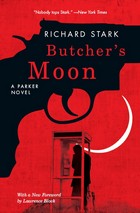 Butcher's Moon: A Parker Novel
Richard Stark
University of Chicago Press, 2011
An action-packed crime novel starring Parker, the heister starring in the forthcoming Shane Black film Play Dirty!
Richard Stark's Parker novels are the hardest of hard-boiled, classic crime novels where the heists are huge, the body counts are high, and the bad guys usually win.
The Parker novels have been a huge influence on countless writers and filmmakers, including Quentin Tarantino, Stephen King, George Pelecanos, Colson Whitehead, Lucy Sante, John Banville, and many more. Their stripped-down language and hard-as-nails amorality create an unforgettable world where the next score could be the big one, but your next mistake could also be your last. There's nothing else like them.
The sixteenth Parker novel, Butcher’s Moon is more than twice as long as most of the master heister’s adventures, and absolutely jammed with the action, violence, and nerve-jangling tension readers have come to expect. Back in the corrupt town where he lost his money, and nearly his life, in Slayground, Parker assembles a stunning cast of characters from throughout his career for one gigantic, blowout job: starting—and finishing—a gang war. It feels like the Parker novel to end all Parker novels, and for nearly twenty-five years that’s what it was. After its publication in 1974, Donald Westlake said, “Richard Stark proved to me that he had a life of his own by simply disappearing. He was gone.”
Featuring a new introduction by Westlake’s close friend and writing partner, Lawrence Block, this classic Parker adventure deserves a place of honor on any crime fan’s bookshelf. More than thirty-five years later, Butcher’s Moon still packs a punch: keep your calendar clear when you pick it up, because once you open it you won’t want to do anything but read until the last shot is fired.
Butcher's Work: True Crime Tales of American Murder and Madness
Harold Schechter
University of Iowa Press, 2022 A Civil War veteran who perpetrated one of the most ghastly mass slaughters in the annals of U.S. crime. A nineteenth-century female serial killer whose victims included three husbands and six of her own children. A Gilded Age “Bluebeard” who did away with as many as fifty wives throughout the country. A decorated World War I hero who orchestrated a murder that stunned Jazz Age America. While other infamous homicides from the same eras—the Lizzie Borden slayings, for example, or the “thrill killing” committed by Leopold and Loeb—have entered into our cultural mythology, these four equally sensational crimes have largely faded from public memory. A quartet of gripping historical true-crime narratives, Butcher’s Work restores these once-notorious cases to vivid, dramatic life.
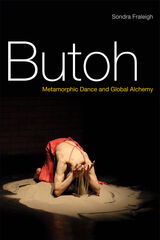 Butoh: Metamorphic Dance and Global Alchemy
Sondra Fraleigh
University of Illinois Press, 2010 Both a refraction of the bombings of Hiroshima and Nagasaki and a protest against Western values, butoh is a form of Japanese dance theater that emerged in the aftermath of World War II. Sondra Fraleigh chronicles the growth of this provocative art form from its mid-century founding under a sign of darkness to its assimilation in the twenty-first century as a poignant performance medium with philosophical and political implications. Through highly descriptive, thoughtful, and emotional prose, Fraleigh traces the transformative alchemy of this metaphoric dance form by studying the international movement inspired by its aesthetic mixtures. While butoh has retained a special identity related to its Japanese background, it also has blossomed into a borderless art with a tolerant and inclusive morphology gaining prominence in a borderless century. Employing intellectual and aesthetic perspectives to reveal the origins, major figures, and international development of the dance, Fraleigh documents the range and variety of butoh artists around the world with first-hand knowledge of butoh performances from 1973 to 2008. Her definitions of butoh's morphology, alchemy, and philosophy set a theoretical framework for poetic and engaging articulations of twenty butoh performances in Japan, Europe, India, and the West. With a blend of scholarly research and direct experience, she also signifies the unfinished nature of butoh and emphasizes its capacity to effect spiritual transformation and bridge cultural differences.
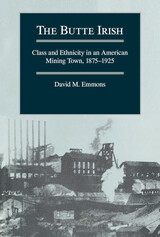 The Butte Irish: Class and Ethnicity in an American Mining Town, 1875-1925
David M. Emmons
University of Illinois Press, 1989 In this pioneering study, David Emmons tells the story of Butte's large and assertive population of Irish immigrants. He traces their backgrounds in Ireland, the building of an ethnic community in Butte, the nature and hazards of their work in the copper mines, and the complex interplay between Irish nationalism and worker consciousness. From a treasure trove of "Irish stuff," the reports, minutes, and correspondence of the major Irish-American organizations in Butte, Emmons shows how the stalwart supporters of the RELA and the Ancient Order of Hiberians marched and drilled for Irish freedom---and how, as they ran the town, the miners' union, and the largest mining companies, they used this tradition of ethnic cooperation to ensure safe and steady work, Irish mines taking care of Irish miners. Butte was new, overwhelmingly Irish, and extraordinarily dangerous---the ideal place to test the seam between class and ethnicity.
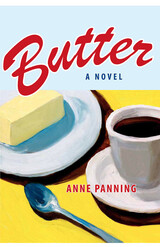 Butter: A Novel
Anne Panning
Northern Illinois University Press, 2012 Anne Panning’s fiction has been described as warm and original by Publishers Weekly, intelligent and humorous by the Boston Globe, graceful and wry by Booklist, and infectious and enchanting by the New York Times. In fact, Panning’s last collection of short stories, Super America, was a New York Times Book Review Editor’s Choice. Enter this exciting new novel, the best work yet from a writer whose astute observations of American life are as honest as they are engaging.
Butter is a coming of age tale set against the backdrop of small-town Minnesota during the 1970s and told from the perspective of an eleven-year-old girl, Iris, who learns from her parents that she is adopted. The story of Iris’s childhood is at first beguiling and innocent: hers is a world filled with bell-bottoms and Barbie dolls, Shrinky Dinks and Shaun Cassidy records, TV dinners and trips to grandma’s. But as her parents’ marriage starts to unravel, Iris grows more and more observant of disintegration all around her, and the simple cadences of her story quickly attain an unnerving tension as she wavers precariously between girlhood and adolescence. In the end, Iris’s story represents a profound meditation on growing up estranged in small town America—on being an outsider in a world increasingly averse to them.
Passionate, lyrical, and disquieting, this intensely moving novel is a rich exploration of a crucial theme in American literature that will confirm Anne Panning’s place as a major figure in the world of contemporary fiction.
Butterflies & Barbarians: Swiss Missionaries and Systems of Knowledge in South-East Africa
Patrick Harries
Ohio University Press, 2007 Swiss missionaries played a primary and little-known role in explaining Africa to the literate world in the late nineteenth and early twentieth centuries. This book emphasizes how these European intellectuals, brought to the deep rural areas of southern Africa by their vocation, formulated and ordered knowledge about the continent.
Central to this group was Junod, who became a pioneering collector in the fields of entomology and botany. He would later examine African society with the methodology, theories, and confidence of the natural sciences. On the way he came to depend on the skills of African observers and collectors. Out of this work emerged, in three stages between 1898 and 1927, an influential classic in the field of South African anthropology, Life of a South African Tribe.
 Butterflies: Ecology and Evolution Taking Flight
Edited by Carol L. Boggs, Ward B. Watt, and Paul R. Ehrlich
University of Chicago Press, 2003 In Butterflies: Ecology and Evolution Taking Flight, the world's leading experts synthesize current knowledge of butterflies to show how the study of these fascinating creatures as model systems can lead to deeper understanding of ecological and evolutionary patterns and processes in general. The twenty-six chapters are organized into broad functional areas, covering the uses of butterflies in the study of behavior, ecology, genetics and evolution, systematics, and conservation biology. Especially in the context of the current biodiversity crisis, this book shows how results found with butterflies can help us understand large, rapid changes in the world we share with them—for example, geographic distributions of some butterflies have begun to shift in response to global warming, giving early evidence of climate change that scientists, politicians, and citizens alike should heed.
The first international synthesis of butterfly biology in two decades, Butterflies: Ecology and Evolution Taking Flight offers students, scientists, and amateur naturalists a concise overview of the latest developments in the field. Furthermore, it articulates an exciting new perspective of the whole group of approximately 15,000 species of butterflies as a comprehensive model system for all the sciences concerned with biodiversity and its preservation.
Contributors:
Carol L. Boggs, Paul M. Brakefield, Adriana D. Briscoe, Dana L. Campbell, Elizabeth E. Crone, Mark Deering, Henri Descimon, Erika I. Deinert, Paul R. Ehrlich, John P. Fay, Richard ffrench-Constant, Sherri Fownes, Lawrence E. Gilbert, André Gilles, Ilkka Hanski, Jane K. Hill, Brian Huntley, Niklas Janz, Greg Kareofelas, Nusha Keyghobadi, P. Bernhard Koch, Claire Kremen, David C. Lees, Jean-François Martin, Antónia Monteiro, Paulo César Motta, Camille Parmesan, William D. Patterson, Naomi E. Pierce, Robert A. Raguso, Charles Lee Remington, Jens Roland, Ronald L. Rutowski, Cheryl B. Schultz, J. Mark Scriber, Arthur M. Shapiro, Michael C. Singer, Felix Sperling, Curtis Strobeck, Aram Stump, Chris D. Thomas, Richard VanBuskirk, Hans Van Dyck, Richard I. Vane-Wright, Ward B. Watt, Christer Wiklund, and Mark A. Willis
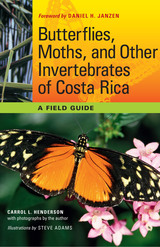 Butterflies, Moths, and Other Invertebrates of Costa Rica: A Field Guide
By Carrol L. Henderson, with photographs by the author
University of Texas Press, 2010 At the biological crossroads of the Americas, Costa Rica hosts an astonishing array of plants and animals—over half a million species! Ecotourists, birders, and biologists come from around the world, drawn by the likelihood of seeing more than three or four hundred species of birds and other animals during even a short stay. To help all these visitors, as well as local residents, identify and enjoy the wildlife of Costa Rica, Carrol Henderson published Field Guide to the Wildlife of Costa Rica in 2002, and it instantly became the indispensable guide. Now Henderson has created a dedicated field guide to more than one hundred tropical butterflies, moths, and other invertebrates that travelers are most likely to see while exploring the wild lands of Costa Rica. He includes fascinating information on their natural history, ecology, identification, and behavior gleaned from his forty years of travels and wildlife viewing, as well as details on where to see these remarkable and beautiful creatures. The butterflies, moths, and other invertebrates are illustrated by over 180 stunning and colorful photographs—most of which were taken in the wild by Henderson. A detailed and invaluable appendix that identifies many of Costa Rica's best wildlife-watching destinations, lodges, and contact information for trip-planning purposes completes the volume.
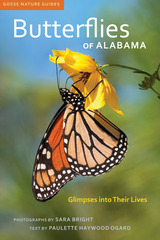 Butterflies of Alabama: Glimpses into Their Lives
Paulette H. Ogard, Sara C. Bright
University of Alabama Press, 2010 Butterflies of Alabama is a full-color, richly illustrated guide to the 84 known species of “true” butterflies (Papilionoidea) found within the state’s borders. For more than 14 years, the authors have made a close study of these showy, winged stars of the insect world, pursuing them in a great variety of habitats, rearing them, and photographing their remarkable life cycle stages—egg, larva (caterpillar), pupa (chrysalid or “cocoon”), and adult.
Each species account is accompanied by color photographs of live subjects in their natural habitats. Close-ups reveal fascinating details of camouflage, mimicry, coloration, and warning devices. The engaging text explains the highly evolved relationships between butterflies and the plants upon which they depend as well as the specialized adaptations that enable their survival within specific environmental niches. Included are range maps, flight times, caterpillar host plants, adult nectar sources, and identification tips—abundant information to tantalize budding as well as experienced butterfly watchers. In addition, pertinent conservation issues are addressed and appendices provide an annotated checklist of the state’s butterflies, a list of accidentals and strays, information on butterfly organizations, and recommended further reading.
With its non-technical language, simple format, and beautiful images, Butterflies of Alabama is accessible and appealing to anyone who appreciates Alabama’s amazing natural wealth.
Publication is supported in part by the Citizens of the City of Selma, Alabama's Butterfly Capital.
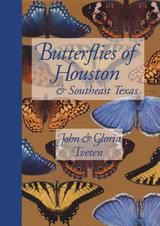 Butterflies of Houston and Southeast Texas
By John and Gloria Tveten
University of Texas Press, 1996 All across the country, butterflies are becoming as popular as birds and wildflowers, especially among people seeking to enjoy the rich natural resources that Texas possesses. John and Gloria Tveten have been studying butterflies in Southeast Texas for thirty-five years, and here they offer their considerable knowledge to everyone who shares their passion for butterflies. In this easy-to-use field guide, the Tvetens describe and illustrate more than 100 species of butterflies that live in Southeast Texas and can often be found across the state. Striking color photographs of living butterflies and caterpillars (a unique addition) show the key marks and characteristics necessary for field identification. The Tvetens' enjoyable and authoritative text describes each species' life history, habits, flight patterns, and characteristic markings. An account of the different butterfly families, from swallowtails to longwings to skippers, precedes the descriptions of the species within each family. The Tvetens also include an interesting discussion of butterfly biology, a complete checklist of area butterflies, an index of butterfly-attracting plants, and pointers to other butterfly resources. This field guide is the first to focus exclusively on Southeast Texas butterflies. It will be the essential reference for everyone seeking a reliable way to identify these butterflies, from field observers to apartment dwellers who wonder what is fluttering around the pot plants on the balcony.
Butterflies of Illinois: A Field Guide
Michael R. Jeffords, Susan L. Post, and James R. Wiker
University of Illinois Press, 2019 Prairie spaces and abundant wildflowers make Illinois an amateur lepidopterist's delight. Butterflies of Illinois offers a portable, easy-to-use guide rich with descriptions, field photography, and life-sized specimen photos of all the state's native species. It also includes:• identification quick guides depicting the tops and undersides of all butterfly species• scientific information and photos that explain life cycles, habitats, and ecology• range maps• flight period charts• key characteristics relevant to field identification• descriptions of rarely seen butterflies and irregular visitors from nearby states• supplemental information on various species, including collection records and unusual sightings Geared toward enthusiasts and experts alike, Butterflies of Illinois is a must-have companion for any nature hike or garden walk.
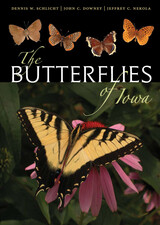 The Butterflies of Iowa
Dennis W. Schlicht
University of Iowa Press, 2007 This beautiful and comprehensive guide, many years in the making, is a manual for identifying the butterflies of Iowa as well as 90 percent of the butterflies in the Plains states. It begins by providing information on the natural communities of Iowa, paying special attention to butterfly habitat and distribution. Next come chapters on the history of lepidopteran research in Iowa and on creating butterfly gardens, followed by an intriguing series of questions and issues relevant to the study of butterflies in the state. The second part contains accounts, organized by family, for the 118 species known to occur in Iowa. Each account includes the common and scientific names for each species, its Opler and Warren number, its status in Iowa, adult flight times and number of broods per season, distinguishing features, distribution and habitat, and natural history information such as behavior and food plant preferences. As a special feature of each account, the authors have included questions that illuminate the research and conservation challenges for each species. In the third section, the illustrations, grouped for easier comparison among species, include color photographs of all the adult forms that occur in Iowa. Male and female as well as top and bottom views are shown for most species. The distribution maps indicate in which of Iowa’s ninety-nine counties specimens have been collected; flight times for each species are shown by marking the date of collection for each verified specimen on a yearly calendar. The book ends with a checklist, collection information specific to the photographs, a glossary, references, and an index. The authors’ meticulous attention to detail, stimulating questions for students and researchers, concern for habitat preservation, and joyful appreciation of the natural world make it a valuable and inspiring volume.
 Butterflies of New Jersey: A Guide to Their Status, Distribution, and Appreciation
Michael Gochfeld and Joanna Burger
Rutgers University Press, 1997 Butterfly watching has begun to gain the popularity that bird watching has enjoyed for half a century. Much as birds served as a flagship of the conservation movement in this country, butterflies are coming to be seen as the rallying point for the protection of invertebrate species--now regarded as increasingly important for the well-being of all members of the ecosystem. Butterflies of New Jersey discusses the behavior, status, distribution, taxonomy, ecology, and conservation of butterflies in New Jersey. It is an innovative companion and complement to any butterfly identification guide of the Northeast. It pays particular attention to the place of butterflies in the ecosystem of New Jersey and neighboring regions and their relationships to other butterflies around the world. Its detailed species accounts of 140-plus kinds of butterflies found in the state and neighboring regions (out of 700 North American species) alert butterfly watchers to changes in populations over time. Where other butterfly guides typically include a section on collecting butterflies, this one includes a detailed chapter on protecting them by creating butterfly gardens and preventing habitat destruction. Butterflies of New Jersey is indispensable for everyone interested in the butterflies and natural history of the Garden State and its neighbor.
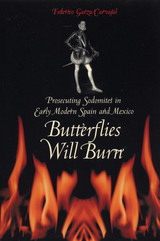 Butterflies Will Burn: Prosecuting Sodomites in Early Modern Spain and Mexico
By Federico Garza Carvajal
University of Texas Press, 2003 As Spain consolidated its Empire in the sixteenth and seventeenth centuries, discourses about the perfect Spanish man or "Vir" went hand-in-hand with discourses about another kind of man, one who engaged in the "abominable crime and sin against nature"—sodomy. In both Spain and Mexico, sodomy came to rank second only to heresy as a cause for prosecution, and hundreds of sodomites were tortured, garroted, or burned alive for violating Spanish ideals of manliness. Yet in reality, as Federico Garza Carvajal argues in this groundbreaking book, the prosecution of sodomites had little to do with issues of gender and was much more a concomitant of empire building and the need to justify political and economic domination of subject peoples. Drawing on previously unpublished records of some three hundred sodomy trials conducted in Spain and Mexico between 1561 and 1699, Garza Carvajal examines the sodomy discourses that emerged in Andalucía, seat of Spain's colonial apparatus, and in the viceroyalty of New Spain (Mexico), its first and largest American colony. From these discourses, he convincingly demonstrates that the concept of sodomy (more than the actual practice) was crucial to the Iberian colonizing program. Because sodomy opposed the ideal of "Vir" and the Spanish nationhood with which it was intimately associated, the prosecution of sodomy justified Spain's domination of foreigners (many of whom were represented as sodomites) in the peninsula and of "Indios" in Mexico, a totally subject people depicted as effeminate and prone to sodomitical acts, cannibalism, and inebriation.
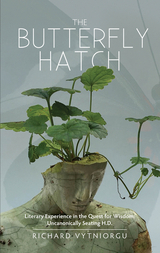 The Butterfly Hatch: Literary Experience in the Quest for Wisdom: Uncanonically Seating H.D.
Richard Vytniorgu
Sussex Academic Press, 2022 Some of H.D.'s most oft-quoted lines have to do with the meaning and value of words; they are conditioned to hatch butterflies. Yet rather than seeking merely to understand how H.D. represented the meaning and value of words, this volume uses 'the butterfly hatch' as a metaphor for thinking more broadly about the capacity of literary experience to hatch transformed persons - 'butterflies' in quest of wisdom. This book reads H.D.'s autobiographical prose and recently published work of the 1940s for its ability to offer new insights into such pertinent and interconnected areas as literary contexts, imagination, and personal and social transformation. The author uncanonically seats her in conversation with the neglected literary theorist, Louise Rosenblatt. This book synthesizes the work of H.D. and Rosenblatt to create an emergent personalist theory of literary experience in the quest for wisdom.Vytniorgu argues that university English studies must incorporate critical and pedagogical vantages which open a window on wisdom as well as knowledge.
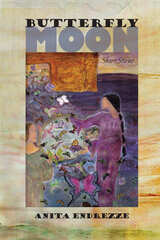 Butterfly Moon: Short Stories
Anita Endrezze
University of Arizona Press, 2012 Anita Endrezze has deep memories. Her father was a Yaqui Indian. Her mother traced her heritage to Slovenia, Germany, Romania, and Italy. And her stories seem to bubble up from this ancestral cauldron. Butterfly Moon is a collection of short stories based on folk tales from around the world. But its stories are set in the contemporary, everyday world. Or are they? Endrezze tells these stories in a distinctive and poetic voice. Fantasy often intrudes into reality. Alternate “realities” and shifting perspectives lead us to question our own perceptions. Endrezze is especially interested in how humans hide feelings or repress thoughts by developing shadow selves. In “Raven’s Moon,” she introduces the shadow concept with a Black Moon, the “unseen reflection of the known.” (Of course the story is about a witch couple who seem very much in love.) The title character in “The Wife Who Lived on Wind” is an ogress who lives in a world somewhat similar to our own, but only somewhat. “The Vampire and the Moth Woman” reveals shape-shifters living among us. Not surprisingly, Trickster appears in these tales. As in Native American stories, Trickster might be a fox or a coyote or a raven or a human—or something in between. “White Butterflies” and “Where the Bones Are” both deal with devastating diseases that swept through Yaqui country in the 1530s. Underneath their surfaces are old Yaqui folktales that feature the greatest Trickster of all: Death (and his little brother Fate). Enjoyably disturbing, these stories linger—deep in our memory.
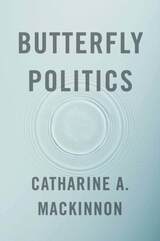 Butterfly Politics
Catharine A. MacKinnon
Harvard University Press, 2017 The minuscule motion of a butterfly’s wings can trigger a tornado half a world away, according to chaos theory. Under the right conditions, small simple actions can produce large complex effects. In this timely and provocative book, Catharine A. MacKinnon argues that the right seemingly minor interventions in the legal realm can have a butterfly effect that generates major social and cultural transformations.
Butterfly Politics brings this incisive understanding of social causality to a wide-ranging exploration of gender relations. The pieces collected here—many published for the first time—provide a new perspective on MacKinnon’s career as a pioneer of legal theory and practice and an activist for women’s rights. Its central concerns of gender inequality, sexual harassment, rape, pornography, and prostitution have defined MacKinnon’s intellectual, legal, and political pursuits for over forty years. Though differing in style and approach, the selections all share the same motivation: to end inequality, including abuse, in women’s lives. Several mark the first time ideas that are now staples of legal and political discourse appeared in public—for example, the analysis of substantive equality. Others urge changes that have yet to be realized.
The butterfly effect can animate political activism and advance equality socially and legally. Seemingly insignificant actions, through collective recursion, can intervene in unstable systems to produce systemic change. A powerful critique of the legal and institutional denial of reality that perpetuates practices of gender inequality, Butterfly Politics provides a model of what principled, effective, socially conscious engagement with law looks like.
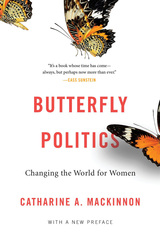 Butterfly Politics: Changing the World for Women, With a New Preface
Catharine A. MacKinnon
Harvard University Press, 2019 “Sometimes ideas change the world. This astonishing, miraculous, shattering, inspiring book captures the origins and the arc of the movement for sex equality. It’s a book whose time has come—always, but perhaps now more than ever.”
—Cass Sunstein, coauthor of Nudge
Under certain conditions, small simple actions can produce large and complex “butterfly effects.” Butterfly Politics shows how Catharine A. MacKinnon turned discrimination law into an effective tool against sexual abuse—grounding and predicting the worldwide #MeToo movement—and proposes concrete steps that could have further butterfly effects on women’s rights. Thirty years after she won the U.S. Supreme Court case establishing sexual harassment as illegal, this timely collection of her previously unpublished interventions on consent, rape, and the politics of gender equality captures in action the creative and transformative activism of an icon.
“MacKinnon adapts a concept from chaos theory in which the tiny motion of a butterfly’s wings can trigger a tornado half a world away. Under the right conditions, she posits, small actions can produce major social transformations.”
—New York Times
“MacKinnon [is] radical, passionate, incorruptible and a beautiful literary stylist… Butterfly Politics is a devastating salvo fired in the gender wars… This book has a single overriding aim: to effect global change in the pursuit of equality.”
—The Australian
“Sexual Harassment of Working Women was a revelation. It showed how this anti-discrimination law—Title VII—could be used as a tool… It was the beginning of a field that didn’t exist until then.”
—U.S. Supreme Court Justice Ruth Bader Ginsburg
Butterfly sleep
Kim Kyung Ju
Tupelo Press, 2019 KIM KYUNG JU’s Butterfly Sleep is a historical drama based in the early period of the Joseon dynasty. He relies on a mixture of absurdism, magic realism, and dark humor in order to tell an existentialist allegory of Korea’s rapid development. In this sense, Butterfly Sleep is a story about the fractured soul of the nation. Even more so, it is a lesson in consolation. As Butterfly Sleep unfolds, we drift in and out of song, as music is made in order to comfort the characters in the play. With lyricism and grace, Kim suggests that the only way the ghosts of the nation can be consoled is through direct confrontation. Confront them first, then sing them a lullaby.
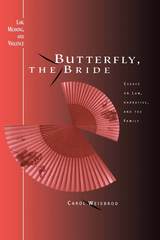 Butterfly, the Bride: Essays on Law, Narrative, and the Family
Carol Weisbrod
University of Michigan Press, 2004 Carol Weisbrod uses a variety of stories to raise important questions about how society, through law, defines relationships in the family. Beginning with a story most familiar from the opera Madame Butterfly, Weisbrod addresses issues such as marriage, divorce, parent-child relations and abuses, and non-marital intimate contact. Each chapter works with fiction or narratives inspired by biography or myth, ranging from the Book of Esther to the stories of Kafka. Weisbrod frames the book with running commentary on variations of the Madame Butterfly story, showing the ways in which fiction better expresses the complexities of intimate lives than does the language of the law.
Butterfly, the Bride looks at law from the outside, using narrative to provide a fresh perspective on the issues of law and social structure---and individual responses to law. This book thoroughly explores relationships between inner and public lives by examining what is ordinarily classified as the sphere of private life---the world of family relationships.
Carol Weisbrod is Ellen Ash Peters Professor of Law at the University of Connecticut. Her other books include The Boundaries of Utopia and Emblems of Pluralism.
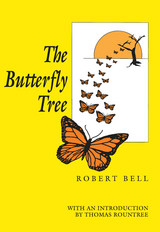 The Butterfly Tree
Robert E. Bell
University of Alabama Press, 1991 A love affair with a place—the legendary eastern shore of Mobile Bay
“There are four buses that leave Mobile daily for Moss Bayou. No matter what time the trains get in from New Orleans or Birmingham, you still have to wait around half the day for one of theses buses if you want to get to Moss Bayou. And a good many people do, for Moss Bayou is a lovely, easygoing resort town, located as it where Magnolia River runs into the bay with worlds of giant live oaks and sandy roads that wind forever under the trailing Spanish moss.”
So begins Robert Bell’s novel that is most of all about a love affair with a place—the legendary eastern shore of Mobile Bay. Published in 1959, the story centers on young Peter Abbott who is about to reach his 21st birthday while visiting the bay area. Peter is drawn into a search for the mythical Butterfly Tree, and finds fulfillment and an end to innocence. In his introduction, Thomas Rountree helps set the stage for a step back in time, and a slowing of pace, as we seek the timeless magic of a special locale that happens to be in Alabama, and in each of us.
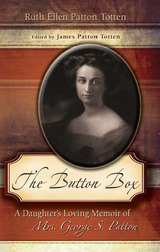 The Button Box: A Daughter's Loving Memoir of Mrs. George S. Patton
Ruth Ellen Patton Totten, Edited by James Patton Totten, Foreward by Carlo W. D'Este
University of Missouri Press, 2005 "There was never a moment in our lives that we were not reminded that our father was the finest, bravest, most gallant, and best-looking man who ever lived and that he was destined for unimaginable glory. This we took for granted. Being our father’s children was a special influence in all our lives, but the greatest, most pervasive, and most interesting influence in my life was Ma." The Button Box is the loving memoir of Beatrice Ayer Patton (1886–1953), the wife of one of the greatest military figures in history, General George S. Patton, Jr. Written by the Pattons’ daughter, Ruth Ellen, the book covers Beatrice’s life from her youth in a wealthy New England family until her death, with an emphasis on her years of marriage to George Patton. A supportive and loving wife, Beatrice was accomplished in her own right as an equestrian, musician, lecturer, sailor, and internationally published author. Courageous and adventurous, Beatrice played a significant role in her husband’s life. Without her, General Patton might never have reached his own level of success. Although there have been numerous books written on George S. Patton, The Button Box provides a unique perspective on the general’s complex personality as well as a rare and intimate look inside his famous American family, a glimpse of the “Old Army” that formed the cadre of the army of World War II, and a detailed description of life “between the wars” in a society not to be seen again. Most important, though, it is the story of a truly fascinating woman, told with love and a rowdy sense of humor by her daughter.
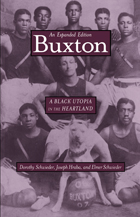 Buxton: A Black Utopia in the Heartland, An Expanded Edition
Dorothy Schwieder
University of Iowa Press, 2003 From 1900 until the early 1920s, an unusual community existed in America's heartland-Buxton, Iowa. Originally established by the Consolidation Coal Company, Buxton was the largest unincorporated coal mining community in Iowa. What made Buxton unique, however, is the fact that the majority of its 5,000 residents were African Americans—a highly unusual racial composition for a state which was over 90 percent white. At a time when both southern and northern blacks were disadvantaged and oppressed, blacks in Buxton enjoyed true racial integration—steady employment, above-average wages, decent housing, and minimal discrimination. For such reasons, Buxton was commonly known as “the black man's utopia in Iowa.” Containing documentary evidence—including newspapers, census records, photographs, and state mining reports—along with interviews of 75 former residents, Buxton: Work and Racial Equality in a Coal Mining Community (originally published in 1987 and winner of the 1988 Benjamin Shambaugh Award) explored the Buxton experience from a variety of perspectives. The authors—an American historian, a family sociologist, and a race relations sociologist—provided a truly interdisciplinary history of one Iowa's most unique communities. Now, eighty years after the town's demise and fifteen years after Buxton's original publication, the history of this Iowa town remains a compelling story that continues to capture people's imaginations. In Buxton: A Black Utopia in the Heartland, the authors offer further reflections upon their original study and the many former Buxton residents who shared their memories. In the new essay, “A Buxton Perspective,” issues such as social class and the town's continuing legacy are addressed. The voices captured in Buxton, although recorded over twenty years ago, still resonate with exuberance, affection, and poignancy; this expanded edition will bring their amazing stories back to the forefront of Iowa and American history.
Buy Black: How Black Women Transformed US Pop Culture
Aria S. Halliday
University of Illinois Press, 2022 Buy Black examines the role American Black women play in Black consumption in the US and worldwide, with a focus on their pivotal role in packaging Black feminine identity since the 1960s. Through an exploration of the dolls, princesses, and rags-to-riches stories that represent Black girlhood and womanhood in everything from haircare to Nicki Minaj’s hip-hop, Aria S. Halliday spotlights how the products created by Black women have furthered Black women’s position as the moral compass and arbiter of Black racial progress. Far-ranging and bold, Buy Black reveals what attitudes inform a contemporary Black sensibility based in representation and consumerism. It also traces the parameters of Black symbolic power, mapping the sites where intraracial ideals of blackness, womanhood, beauty, play, and sexuality meet and mix in consumer and popular culture.
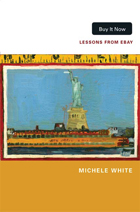 Buy It Now: Lessons from eBay
Michele White
Duke University Press, 2012 In Buy It Now, Michele White examines eBay and its emphasis on community and social norms, revealing the cultural assumptions about gender, race, and sexuality that are reinforced throughout the site. She shows how instructional texts, rule systems, and advertisements "configure the user," allowing eBay to indicate how the site is supposed to function while also upholding particular values and practices. White details how eBay reinforces stereotypes about gender and sexuality, looking, for example, at descriptions included in wedding dress listings, and how eBay directs individuals to the "Adult Only" part of the website when they use the search terms "gay" and "lesbian." She discloses the ways that eBay promises a caring community but its "Black Americana" category reproduces racism by allowing sellers' narratives that excuse and romanticize slavery and insult African Americans. White also looks at how participants challenge eBay's categories, rules, and values, examining widely used strategies of resistance by sellers and buyers in the lesbian and gay interest listings. By analyzing the organizational and cultural logics present in eBay, White emphasizes how other Internet settings, including craigslist, are not as transparent, community-oriented, and empowering as they claim. She proposes methods for researching and reconceptualizing new media sites.
Buyers Beware: Insurgency and Consumption in Caribbean Popular Culture
Patricia Joan Saunders
Rutgers University Press, 2022 Buyers Beware offers a new perspective for critical inquiries about the practices of consumption in (and of) Caribbean popular culture. The book revisits commonly accepted representations of the Caribbean from “less respectable” segments of popular culture such as dancehall culture and 'sistah lit' that proudly jettison any aspirations toward middle-class respectability. Treating these pop cultural texts and phenomena with the same critical attention as dominant mass cultural representations of the region allows Patricia Joan Saunders to read them against the grain and consider whether and how their “pulp” preoccupation with contemporary fashion, music, sex, fast food, and television, is instructive for how race, class, gender, sexuality and national politics are constructed, performed, interpreted, disseminated and consumed from within the Caribbean.
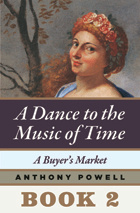 A Buyer's Market: Book 2 of A Dance to the Music of Time
Anthony Powell
University of Chicago Press, 1952 Anthony Powell’s universally acclaimed epic A Dance to the Music of Time offers a matchless panorama of twentieth-century London. Now, for the first time in decades, readers in the United States can read the books of Dance as they were originally published—as twelve individual novels—but with a twenty-first-century twist: they’re available only as e-books.
The second volume, A Buyer’s Market (1952),finds young Nick Jenkins struggling to establish himself in London. Amid the fever of the 1920s, he attends formal dinners and wild parties; makes his first tentative forays into the worlds of art, culture, and bohemian life; and suffers his first disappointments in love. Old friends come and go, but the paths they once shared are rapidly diverging: Stringham is settling into a life of debauchery and drink, Templer is plunging into the world of business, and Widmerpool, though still a figure of out-of-place grotesquerie, remains unbowed, confident in his own importance and eventual success. A Buyer’s Market is a striking portrait of the pleasures and anxieties of early adulthood, set against a backdrop of London life and culture at one of its most effervescent moments.
"Anthony Powell is the best living English novelist by far. His admirers are addicts, let us face it, held in thrall by a magician."--Chicago Tribune
"A book which creates a world and explores it in depth, which ponders changing relationships and values, which creates brilliantly living and diverse characters and then watches them grow and change in their milieu. . . . Powell's world is as large and as complex as Proust's."--Elizabeth Janeway, New York Times
"One of the most important works of fiction since the Second World War. . . . The novel looked, as it began, something like a comedy of manners; then, for a while, like a tragedy of manners; now like a vastly entertaining, deeply melancholy, yet somehow courageous statement about human experience."--Naomi Bliven, New Yorker “The most brilliant and penetrating novelist we have.”--Kingsley Amis
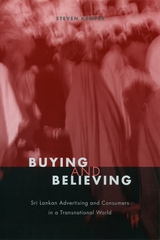 Buying and Believing: Sri Lankan Advertising and Consumers in a Transnational World
Steven Kemper
University of Chicago Press, 2001 Advertising is a central part of the global system of commerce and culture. Every day it exposes consumers around the world to practices associated with the West, urban life, prosperity, and modernity. One consequence of this exposure is that it frees people's imaginations from time and place, and imposes a new and foreign reality. In this book Steven Kemper looks at a parallel trend, arguing that advertising firms in Nairobi, Caracas, and Colombo also domesticate the imagination, insinuating images into people's minds of the traditional as well as the modern, the local as much as the global.
Drawing upon fieldwork conducted over thirty years, Kemper examines the Sri Lankan advertising industry to show how executives draw on their skills as folk ethnographers to "Sri Lankanize" commodities and practices to make them locally desirable, essentially producing new forms of Sri Lankan culture. Addressing many of the most pressing agendas of contemporary anthropology, Buying and Becoming breaks new ground in studies of culture and globalization.
 Buying In or Selling Out?: The Commercialization of the American Research University
Stein, Donald G.
Rutgers University Press, 2004 Universities were once ivory towers where scholarship and teaching reigned supreme, or so we tell ourselves. Whether they were ever as pure as we think, it is certainly the case that they are pure no longer. Administrators look to patents as they seek money by commercializing faculty discoveries; they pour money into sports with the expectation that these spectacles will somehow bring in revenue; they sign contracts with soda and fast-food companies, legitimizing the dominance of a single brand on campus; and they charge for distance learning courses that they market widely. In this volume, edited by Donald G. Stein, university presidents and others in higher education leadership positions comment on the many connections between business and scholarship when intellectual property and learning is treated as a marketable commodity. Some contributors write about the benefits of these connections in providing much needed resources. Others emphasize that the thirst for profits may bias the type of research that is carried out and the quality of that research. They fear for the future of basic research if faculty are in search of immediate payoffs.
The majority of the contributors acknowledge that commercialization is the current reality and has progressed too far to return to the “good old days.” They propose guidelines for students and professors to govern commercial activities. Such guidelines can increase the likelihood that quality, openness, and collegiality will remain core academic values.
Buying into English: Language and Investment in the New Capitalist World
Catherine Prendergast
University of Pittsburgh Press, 2008
Many developing countries have little choice but to “buy into English” as a path to ideological and material betterment.
Based on extensive fieldwork in Slovakia, Prendergast assembles a rich ethnographic study that records the thoughts, aspirations, and concerns of Slovak nationals, language instructors, journalists, and textbook authors who contend with the increasing importance of English to their rapidly evolving world. She reveals how the use of English in everyday life has becomes suffused with the terms of the knowledge and information economy, where language is manipulated for power and profit.
Buying into English presents an astute analysis of the factors that have made English so prominent and yet so elusive, and a deconstruction of the myth of guaranteed viability for new states and economies through English.
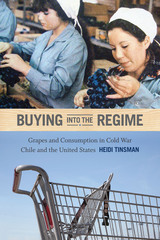 Buying into the Regime: Grapes and Consumption in Cold War Chile and the United States
Heidi Tinsman
Duke University Press, 2014 Buying into the Regime is a transnational history of how Chilean grapes created new forms of consumption and labor politics in both the United States and Chile. After seizing power in 1973, Augusto Pinochet embraced neoliberalism, transforming Chile’s economy. The country became the world's leading grape exporter. Heidi Tinsman traces the rise of Chile's fruit industry, examining how income from grape production enabled fruit workers, many of whom were women, to buy the commodities—appliances, clothing, cosmetics—flowing into Chile, and how this new consumerism influenced gender relations, as well as pro-democracy movements. Back in the United States, Chilean and U.S. businessmen aggressively marketed grapes as a wholesome snack. At the same time, the United Farm Workers and Chilean solidarity activists led parallel boycotts highlighting the use of pesticides and exploitation of labor in grape production. By the early-twenty-first century, Americans may have been better informed, but they were eating more grapes than ever.
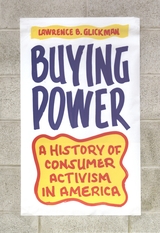 Buying Power: A History of Consumer Activism in America
Lawrence B. Glickman
University of Chicago Press, 2009 A definitive history of consumer activism, Buying Power traces the lineage of this political tradition back to our nation’s founding, revealing that Americans used purchasing power to support causes and punish enemies long before the word boycott even entered our lexicon. Taking the Boston Tea Party as his starting point, Lawrence Glickman argues that the rejection of British imports by revolutionary patriots inaugurated a continuous series of consumer boycotts, campaigns for safe and ethical consumption, and efforts to make goods more broadly accessible. He explores abolitionist-led efforts to eschew slave-made goods, African American consumer campaigns against Jim Crow, a 1930s refusal of silk from fascist Japan, and emerging contemporary movements like slow food. Uncovering previously unknown episodes and analyzing famous events from a fresh perspective, Glickman illuminates moments when consumer activism intersected with political and civil rights movements. He also sheds new light on activists’ relationship with the consumer movement, which gave rise to lobbies like the National Consumers League and Consumers Union as well as ill-fated legislation to create a federal Consumer Protection Agency.
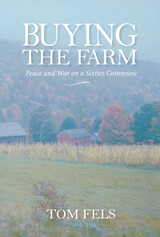 Buying the Farm: Peace and War on a Sixties Commune
Tom Fels
University of Massachusetts Press, 2012 This book tells the story of Montague Farm, an early back-to-the land communal experiment in western Massachusetts, from its beginning in 1968 through the following thirty-five years of its surprisingly long life. Drawing on his own experience as a resident of the farm from 1969 to 1973 and decades of contact with the farm's extended family, Tom Fels provides an insightful account of the history of this iconic alternative community. He follows its trajectory from its heady early days as a pioneering outpost of the counterculture through many years of change, including a period of renewed political activism and, later, increasing episodes of conflict between opposing factions to determine what the farm represented and who would control its destiny.
With deft individual portraits, Fels reveals the social dynamics of the group and explores the ongoing difficulties faced by a commune that was founded in idealism and sought to operate on the model of a leaderless democracy. He draws on a large body of farm-family and 1960s-related writing and the notes of community members to present a variety of points of view. The result is an absorbing narrative that chronicles the positive aspects of Montague Farm while documenting the many challenges and disruptions that marked its history.
Buying the Night Flight: The Autobiography of a Woman Foreign Correspondent
Georgie Anne Geyer
University of Chicago Press, 2001 Buying the Night Flight is Georgie Anne Geyer's retelling of her thrilling rise from cub reporter to foreign correspondent as she made her way into the male-dominated world of journalism. Geyer transports the reader to Guatemala, Cuba, Egypt, Russia, and Cambodia, recounting the history and politics, adventure and exhaustion of the time from a truly unique perspective. Told with brilliance and dead-on honesty, this book vividly captures the triumphs of a determined and talented young reporter.
Buying the Wind: Regional Folklore in the United States
Richard M. Dorson
University of Chicago Press, 1964 This anthology of regional folklore displays the abundance, humor, and continuing vigor of the American oral tradition. The collection explores rich and distinctive lore of Maine Down-Easters, Pennsylvania Dutchmen, Southern mountaineers, Louisiana Cajuns, Illinois Egyptians, Southwest Mexicans, and Utah Mormons.
Their tales, songs, riddles, proverbs, games, superstitions, and customs provide a wealth of living folklore presented here as it was recorded in the field. And this unvarnished folklore fact—retains the spicy flavor of authentic narrative, told in the vernacular of the skillful folk storyteller.
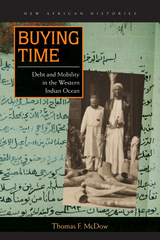 Buying Time: Debt and Mobility in the Western Indian Ocean
Thomas F. McDow
Ohio University Press, 2018 In Buying Time, Thomas F. McDow synthesizes Indian Ocean, Middle Eastern, and East African studies as well as economic and social history to explain how, in the nineteenth century, credit, mobility, and kinship knit together a vast interconnected Indian Ocean region. That vibrant and enormously influential swath extended from the desert fringes of Arabia to Zanzibar and the Swahili coast and on to the Congo River watershed. In the half century before European colonization, Africans and Arabs from coasts and hinterlands used newfound sources of credit to seek out opportunities, establish new outposts in distant places, and maintain families in a rapidly changing economy. They used temporizing strategies to escape drought in Oman, join ivory caravans in the African interior, and build new settlements. The key to McDow’s analysis is a previously unstudied trove of Arabic business deeds that show complex variations on the financial transactions that underwrote the trade economy across the region. The documents list names, genealogies, statuses, and clan names of a wide variety of people—Africans, Indians, and Arabs; men and women; free and slave—who bought, sold, and mortgaged property. Through unprecedented use of these sources, McDow moves the historical analysis of the Indian Ocean beyond connected port cities to reveal the roles of previously invisible people.
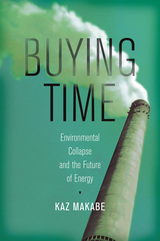 Buying Time: Environmental Collapse and the Future of Energy
Kaz Makabe
University Press of New England, 2017 WE KNOW, from repeated failures to predict and prevent catastrophes ranging from the Great Tohoku Earthquake to the global financial crisis of 2008, that complex adaptive systems, such as those found in nature or in economies, are actually very hard to predict, much less influence. Today, we face environmental degradation caused in large part by the use of fossil fuels, ever-declining efficiencies in extracting them, a pace of development for renewable energy insufficient for replacement of the fossil fuels we are burning through, and population growth that is likely to add two billion people globally by 2045. Despite partial recovery since the financial crisis of 2008, growth remains sluggish, and large budget deficits persist across much of the developed world. Meanwhile, developing states face their own challenges, stemming from unbalanced growth. Against this backdrop, and in light of the urgent need to pay closer heed to our environment, the last thing the world needs is an energy crisis triggered not merely by recurrent scares over supply, but by more lasting structural changes in our ability to use fossil fuels with reckless abandon. Buying Time applies lessons learned the hard way from the global economic crisis of the past decade, to offer an overview of the state of the environment and our energy future. Grounded in subtle thinking about complex systems, including the economy, energy, and the environment, this book underscores the connections linking them all. Kaz Makabe is a veteran financial systems expert who lived through the Fukushima Daiichi nuclear disaster. He nevertheless concludes that nuclear energy is the bridge than can help us cross over the abyss we face.
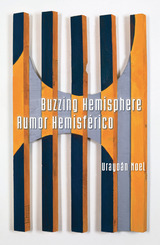 Buzzing Hemisphere / Rumor Hemisférico
Urayoán Noel
University of Arizona Press, 2015 Is poetry an alternative to or an extension of a globalized language? In Buzzing Hemisphere / Rumor Hemisférico, poet Urayoán Noel maps the spaces between and across languages, cities, and bodies, creating a hemispheric poetics that is both broadly geopolitical and intimately neurological.
In this expansive collection, we hear the noise of cities such as New York, San Juan, and São Paulo abuzz with flickering bodies and the rush of vernaculars as untranslatable as the murmur in the Spanish rumor. Oscillating between baroque textuality and vernacular performance, Noel’s bilingual poems experiment with eccentric self-translation, often blurring the line between original and translation as a way to question language hierarchies and allow for translingual experiences.
A number of the poems and self-translations here were composed on a smartphone, or else de- and re-composed with a variety of smartphone apps and tools, in an effort to investigate the promise and pitfalls of digital vernaculars. Noel’s poetics of performative self-translation operates not only across languages and cultures but also across forms: from the décima and the “staircase sonnet” to the collage, the abecedarian poem, and the performance poem.
In its playful and irreverent mash-up of voices and poetic traditions from across the Americas, Buzzing Hemisphere / Rumor Hemisférico imagines an alternative to the monolingualism of the U.S. literary and political landscape, and proposes a geo-neuro-political performance attuned to damaged or marginalized forms of knowledge, perception, and identity.
By Accident or Design: Challenges and Coincidences in My Life
Rosemary Sassoon
Intellect Books, 2018 In this reflective autobiography, Rosemary Sassoon, a leading expert on handwriting and typography, looks back on her long and varied career, paying special attention to her unorthodox progression through a variety of fields. She details the route that took her from design to the educational and medical aspects of handwriting problems, then on to research and a PhD, and finally to working in the area of legibility in type design. In telling the story of an unusual and unusually successful life, Sassoon takes up a number of philosophical questions about what it is that comes together to form our characters, and what role chance and coincidence play in our lives.
By Airship to the North Pole: An Archaeology of Human Exploration
Capelotti, P. J
Rutgers University Press, 1999 By Airship to the North Pole chronicles the adventures of Swedish engineer Salomon August Andree, who made the first failed attempt to reach the North Pole in a hydrogen balloon in 1897, and of American journalist Walter Wellman who organized and led three unsuccessful air expeditions from 1907 to 1909. The book investigates the stories behind the quests to reach this remote and inhospitable outpost by air and examines how those stories were created and reported by the press. What he uncovers allows readers to reflect on the distortions of the written historical record, particularly unkind to Wellman, and what that may tell us about our own age of exploration as we look to the last frontiers in space.
By Authors Possessed: The Demonic Novel in Russia
Adam Weiner
Northwestern University Press, 1998 By Authors Possessed examines the development of the demonic in key Russian novels from the last two centuries. Defining the demonic novel as one that takes as its theme an evil presence incarnated in the protagonists and attributed to the Judeo-Christian Devil, Adam Weiner investigates the way the content of such a book can compromise the moral integrity of its narration and its sense of authorship.
Weiner contends that the theme of demonism increasingly infects the narrative point of view from Gogol's Dead Souls to Dostoevsky's The Devils and Bely's Petersburg, until Nabokov exorcised the demonic novel through his fiction and his criticism. Starting from the premise that artistic creation has always been enshrouded in a haze of moral dilemma and religious doubt, Weiner's study of the demonic novel is an attempt to illuminate the potential ethical perils and aesthetic gains of great art.
 By Design: Planning Research on Higher Education
Richard J. Light, Judith D. Singer, and John B. Willett
Harvard University Press, 1990 Do students who work longer and harder learn more in college? Does joining a fraternity with a more academic flavor enhance a student's academic performance? When are the results from an innovation that is tried on one campus applicable to other campuses? How many students and faculty members must participate in a research project before findings are valid? Do students learn best when they study alone or in small groups?These are just some more than fifty examples that Richard Light Judith Singer and John Willett explore in By Design, a lively nontechnical sourcebook for learning about colleges and universities. These authors believe that careful design of research on college effectiveness is the single most important step toward producing useful and valid findings. In that spirit, By Design is a pathbreaking textbook of modern research methods that both practitioners and students will find useful.
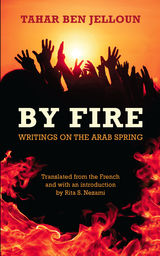 By Fire: Writings on the Arab Spring
Tahar Ben Jelloun, translated and with an introduction by Rita Nezami
Northwestern University Press, 2016 Tahar Ben Jelloun’s By Fire, the first fictional account published on the Arab Spring, reimagines the true-life self-immolation of Mohamed Bouazizi in Tunisia, an event that has been credited with setting off the Tunisian revolt. The novella depicts the days leading up to Bouazizi’s self-immolation. Ben Jelloun’s deliberate ambiguity about the location of the story, set in an unnamed Islamic country, allows the reader to imagine the experiences and frustrations of other young men who have endured physical violence and persecution in places beyond Tunisia. The tale begins and ends in fire, and the imagery of burning frames the political accounts in The Spark, Ben Jelloun’s nonfiction writings on the Tunisian events that provide insight into the despotic regimes that drove Bouazizi to such despair. Rita S. Nezami’s elegant translations and critical introduction provide the reader with multiple strategies for approaching these potent texts.
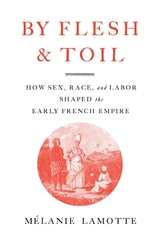 By Flesh and Toil: How Sex, Race, and Labor Shaped the Early French Empire
Mélanie Lamotte
Harvard University Press, 2025 A richly detailed transoceanic history of the early French Empire, illuminating how it became bound by a common legal culture of race—as well as how enslaved and free people critically shaped the development of the colonies.
From the beginning of the seventeenth century, French colonies and trading posts sprawled across the Atlantic and Indian Oceans. In the first pan-imperial history of the early French Empire in the English language, Mélanie Lamotte shows how an increasingly cohesive legal culture came to govern the lives of enslaved and free people of African, Malagasy, South Asian, and Native American descent. She also illuminates the important role played by these populations in the development of the empire, from Louisiana to Guadeloupe, Senegambia, Madagascar, Isle Bourbon, and India.
The early French Empire has often been portrayed as a fragmented conglomerate of isolated colonies or regions. Yet Lamotte shows that racial policies issued by the metropole, as well as by officials in the Atlantic and Indian Oceans, significantly influenced one another. Rather than focusing on the actions of administrators, however, Lamotte also reveals the extensive influence of people on the ground—especially those of non-European descent. Through their sexuality and their labor, along with their socio-economic and political endeavors, they played a critical role in building the empire and setting its limits. As they sought justice for themselves, strove to protect their kin, and aimed to improve their social conditions, these individuals also pushed against the advancement of white dominion in unexpected ways.
Archivally rich and rigorously documented, By Flesh and Toil illuminates the transoceanic connections that united the French colonial world—and recasts people of African, Malagasy, South Asian, and Native American descent as key actors in the story of empire-building.
By Heart De Memoria: Cuban Women'S Journeys In/Out Of Exile
Maria De Los Angeles Torre
Temple University Press, 2003 In this moving account of the Cuban Revolution and its aftermath, eleven women who lived through it as children or young adults recall the events of the last forty years. In Torres's words, "This book, which began in Miami, looking toward the island, ends on the island as it gazes toward the exile community."These poets, artists and scholars represent each post-revolution exile generation. Some left Cuba in the Peter Pan airlift, some left afterward, some never left at all. Others—like the editor—left as children only to return and leave again, disillusioned with both the exile community and with Castro's island. Together they testify to the powerful intersections of memory, politics, nation, and exile.
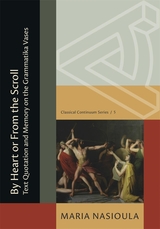 By Heart or From the Scroll: Text Quotation and Memory on the Grammatika Vases
Maria Nasioula
Harvard University Press Grammatika vases, one of the most distinctive varieties of Hellenistic relief pottery, present modern scholars with compelling research opportunities, as they document the reception of ancient Greek literature in the Hellenistic world in various ways. Focusing on the group of grammatika vases that feature citations, By Heart or From the Scroll offers new insights into the archaeological material within its broader literary and historical contexts.
This study is based on a collection of six vases—two Boeotian bowls and four Macedonian fragments—all of which depict scenes inspired by Book 22 of the Odyssey, detailing the slaughter of the suitors by Odysseus. These vases provide a direct glimpse into the transmission of the ancient text within a particularly intriguing—and in some cases well-dated—archaeological context, establishing a reference point for other vases of the same category. The thorough examination of the script used in the citations, coupled with its juxtaposition to the epigraphic and calligraphic literary scripts found on contemporary papyri, reveals a remarkable correspondence and offers a key to understanding this type of pottery, shedding light on the people behind its production and use.
Drawing on both archaeological and epigraphic evidence, and guided by Athenaeus’ testimony regarding Dionysius Thrax and his silver Νεστορίς, this interdisciplinary approach provides a novel interpretation of the literary sources cited on these grammatika vases and a reliable terminus post quem for dating excavation efforts in Macedonia and beyond.
 By Heart: Reflections of a Rust Belt Bard
Philip Brady
University of Tennessee Press, 2019 With a perfect balance of playfulness, humor, and apology, Philip Brady calls himself a bard. But he explains that, before the title became shrouded in mystery, bards were simply teachers, unknown and poor, who gave literal voice to poems through recitations. Woven throughout these twenty essays is Brady's resistance to the academic expectations and settings of poetic instruction, enabling him to elicit the most authentic and surprising responses from a range of voices. He is motivated by the possibility of poetry expressed in the grittiest of places and takes readers from the rust belts of Ohio, to the far-flung pubs of Ireland, to Zairian classrooms with few books and fidgety lightbulbs. Most of all, he believes that, while bad poetry is a fact of life, good poetry should be studied and learned by heart.
Brady doesn't resort to dissecting poems here, though poems-his own and those of many of his masters, from Yeats to Tu Fu-do appear. Instead, the poetic language of his observations seems to fulfill a greater purpose: “Voiced, the poem is transfigured from a printed glyph to sensory language: ephemeral, but with a tensile strength derived from the collective memory that births it. Critics may feel differently, but what matters to a poem is not how many times it is reprinted, but how deeply it penetrates the heart.”
These essays are meditations grounded in the author's life as a poet, teacher, publisher, musician, traveler, and organizer. In one, readers encounter non-traditional students who attend class after work and whose lives are already shaped by burden. Brady recognizes the tension between reading poetry as an academic exercise and reading it for its power to endow all people with a broader sense of the self that is informed by both the dead and the living. He celebrates the challenges that his students bring to the classroom by forging headlong into discussions that other instructors would cringe at-as when a student declares that he doesn't like reading old poetry but instead likes greeting-card poems. Brady masterfully turns this potentially deflating moment into one that is both validating and deeply inspiring-for student and reader.
By Invitation Only: The Rise of Exclusive Politics in the United States
Steven Schier
University of Pittsburgh Press, 2000 Steven Schier examines the shift in U.S. politics to activation—the political variant of niche marketing. This method encourages only a strategically selected few to get involved, resulting in a decline of majority rule in American politics.
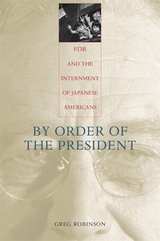 By Order of the President: FDR and the Internment of Japanese Americans
Greg Robinson
Harvard University Press, 2001 On February 19, 1942, following the Japanese bombing of Pearl Harbor and Japanese Army successes in the Pacific, President Franklin Delano Roosevelt signed a fateful order. In the name of security, Executive Order 9066 allowed for the summary removal of Japanese aliens and American citizens of Japanese descent from their West Coast homes and their incarceration under guard in camps. Amid the numerous histories and memoirs devoted to this shameful event, FDR's contributions have been seen as negligible. Now, using Roosevelt's own writings, his advisors' letters and diaries, and internal government documents, Greg Robinson reveals the president's central role in making and implementing the internment and examines not only what the president did but why.
Robinson traces FDR's outlook back to his formative years, and to the early twentieth century's racialist view of ethnic Japanese in America as immutably "foreign" and threatening. These prejudicial sentiments, along with his constitutional philosophy and leadership style, contributed to Roosevelt's approval of the unprecedented mistreatment of American citizens. His hands-on participation and interventions were critical in determining the nature, duration, and consequences of the administration's internment policy.
By Order of the President attempts to explain how a great humanitarian leader and his advisors, who were fighting a war to preserve democracy, could have implemented such a profoundly unjust and undemocratic policy toward their own people. It reminds us of the power of a president's beliefs to influence and determine public policy and of the need for citizen vigilance to protect the rights of all against potential abuses.
 By the Noble Daring of Her Sons: The Florida Brigade of the Army of Tennessee
Jonathan C. Sheppard
University of Alabama Press, 2012 A fascinating account of Floridians who served in the Confederate army and the changes to Florida society and politics that resulted from the state's Confederate experience
Until recently Florida’s Confederate soldiers have received scant attention. This volume explores the story of Florida soldiers going to war, families left behind, a white population fighting to maintain a society built on slavery, and a state torn by political and regional strife.
Before the war Florida’s inhabitants engaged in bitter political rivalries. Sheppard argues that prior to secession Florida citizens maintained regional loyalties rather than considering themselves “Floridians.” He argues that service in Confederate armies eased tensions between political factions and fostered solidarity among white Floridians. In this illuminated account, Sheppard also addresses the practices of prisoner parole and exchange, unit consolidation and its effects on morale and unit identity, politics within the Army of Tennessee, and conscription and desertion in the Southern armies. These issues come together to demonstrate the connection between the front lines and the home front.
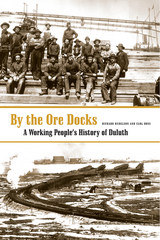 By The Ore Docks: A Working People’s History Of Duluth
Richard Hudelson
University of Minnesota Press, 2006 Located on the shore of Lake Superior near the Iron Range of Minnesota and, for much of its history, the site of vast steel, lumber, and shipping industries, Duluth has been home to people who worked tirelessly in the rail yards, grain elevators, and harbor. Here, for the first time, By the Ore Docks presents a compelling, full-length history of the people who built this port city and struggled for both the growth of the city and the rights of their fellow workers.
In By the Ore Docks, Richard Hudelson and Carl Ross trace seventy years in the lives of Duluth’s multi-ethnic working class—Scandinavians, Finns, Italians, Poles, Irish, Jews, and African Americans—and chronicle, along with the events of the times, the city’s vibrant neighborhoods, religious traditions, and communities. But they also tell the dramatic story of how a populist worker’s coalition challenged the “legitimate American” business interests of the city, including the major corporation U.S. Steel.
From the Knights of Labor in the 1880s to the Industrial Workers of the World, the AFL and CIO, and the Democratic Farmer-Labor party, radical organizations and their immigrant visionaries put Duluth on the national map as a center in the fight for worker’s rights—a struggle inflamed by major strikes in the copper and iron mines.
By the Ore Docks is at once an important history of Duluth and a story of its working people, common laborers as well as union activists like Ernie Pearson, journalist Irene Paull, and Communist party gubernatorial candidate Sam Davis. Hudelson and Ross reveal tension between Duluth’s ethnic groups, while also highlighting the ability of the people to overcome those differences and shape the legacy of the city’s unsettled and remarkable past.
Richard Hudelson is professor of philosophy at the University of Wisconsin, Superior. He is the author of, among other works, Marxism and Philosophy in the Twentieth Century and The Rise and Fall of Communism.
Carl Ross (1913–2004) was a labor activist and the author of The Finn Factor in American Labor, Culture, and Society. He was director of the Twentieth-Century Radicalism in Minnesota Project of the Minnesota Historical Society.
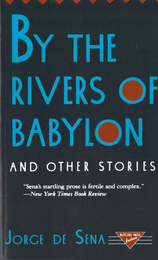 By the Rivers of Babylon and Other Stories
Patai, Daphne
Rutgers University Press, 1991 This modest collection of short stories, written between 1946 and 1964, is the first by this influential Portuguese man of letters to be published in English. Their subjects often prominent historical figures, all are densely written, cerebral. The title story describes the tortured creative process of a famous 16th century Portuguese poet as he sets out to write his most celebrated poem. "A Night of Nativity" reports a fervent conversation between a Roman tribune and St. Paul. The whimsical "Sea of Stones" tells how the seventh century English monk, the Venerable Bede, forced the stones of an ancient Druid temple to speak. These 11 short stories are for the most part highly moralistic, at their best arguing the strict Catholic tenets of faith; less successful are the author's anguished attempts to describe the artistic temperament. Tantalizing by the promise they show, the short narratives are unfleshed, lacking the spark of animation. As a collection, with an informative foreword by the author's close colleague, they supplement our scant knowledge of this scholar and social activist.
By the Sweat of the Brow: Literature and Labor in Antebellum America
Nicholas K. Bromell
University of Chicago Press, 1993 The spread of industrialism, the emergence of professionalism, and the challenge to slavery fueled an anxious debate about the meaning and value of work in antebellum America.
In chapters on Thoreau, Melville, Hawthorne, Rebecca Harding Davis, Susan Warner, Harriet Beecher Stowe, and Frederick Douglass, Nicholas Bromell argues that American writers generally sensed a deep affinity between the mental labor of writing and such bodily labors as blacksmithing, house building, housework, mothering, and farming. Combining literary and social history, canonical and noncanonical texts, primary source material, and contemporary theory, Bromell establishes work as an important subject of cultural criticism.
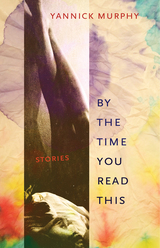 By the Time You Read This: Stories
Yannick Murphy
University of Alabama Press, 2021 WINNER OF FC2’s CATHERINE DOCTOROW INNOVATIVE FICTION PRIZE
A gathering of luminescent stories that illustrates how fraught and contingent the simplest of lives can be, and the often unexpected means available to each of us for our own salvation
The truths revealed and the lives upended in the 13 stories that make up Yannick Murphy’s By the Time You Read This are at once singularly foreign and uncannily familiar. A wife pens a series of suicide notes to her family that verge on the comic, hovering between the tyrannical and the absurd. A mother obsesses over what her child eats. A young girl left with caretakers in New York draws on her potent imagination with consequences in real life that are both liberating and disastrous. In a college application essay a young woman finally begins to make sense of the troubling vicissitudes of her existence. A young French girl departs for America with her reprehensible beau to find she’s as much a stranger to herself abroad as she was at home. As with her previous novels and story collections, Murphy’s keen rendering of these disparate, complex lives illuminate in ways both quiet and startling our capacity for deliverance and devastation through daring acts of self-invention.
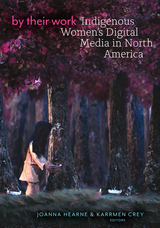 By Their Work: Indigenous Women's Digital Media in North America
Joanna Hearne
University of Minnesota Press, 2025 A first-of-its-kind collection to transform our understanding of digital media from Indigenous women creators
Indigenous women form a vital force in digital media production now and have over the past several decades—in fact, nearly three quarters of the projects at the 2017 imagineNATIVE Film and Media Arts Festival were created by women. By Their Work highlights the prismatic nature of Indigenous women’s digital media, connecting the digital arts with their creative labor and adaptive activism. Joanna Hearne and Karrmen Crey bring together a collection of essays and interviews to highlight the voices of powerful and important media makers, from Indigenous video game creators to animators to social media influencers and from theorists of early Indigenous digital media to current practitioners, including trans and nonbinary creators often left out of public narratives about the digital. Creating a space to hear critical voices on Indigenous media history, theory, and production, the contributors share stories, genealogies, and practices behind Indigenous women’s power and presence in the digital world. Focusing on the history of digital media as a whole, this collection presents a compelling case for Indigenous women’s crucial roles across the history of digital forms and platforms. In doing so, By Their Work transforms digital Indigenous studies in the twenty-first century. Contributors: Nanobah Becker; Reilley Bishop-Stall, McGill U; Meagan Byrne; Tawny Trottier Cale; Dana Claxton; Crystal Harrison Collin; Elizabeth Day; Kristin L. Dowell, Florida State U; Miranda Due; Heid E. Erdrich; Marcella Ernest, U of New Mexico; Marisa Erven; David Gaertner, U of British Columbia; Carol Geddes; Faye Ginsburg, New York U; Patuk N. Glenn; Lisa Jackson; Jacqueline Land, William Jewell College; Jason Edward Lewis, Concordia University, Montreal; Joshua D. Miner, U of Kansas; Salma Monani, Gettysburg College; Jas M. Morgan, Simon Fraser U; Archer Pechawis, York U; Mikhel Proulx, Queen’s U Canada; Ryan Rice; Jolene Rickard, Cornell U; Channette Romero, U of Georgia; Wendi Sierra, Texas Christian U; Skawennati.
 By Touch Alone: Blindness and Reading in Nineteenth-Century Culture
Vanessa Warne
University of Michigan Press, 2025 By Touch Alone demonstrates how reading by touch not only changed the lives of nineteenth-century blind people, but also challenged longstanding perceptions about blindness and reading. Over the course of the nineteenth century, thousands of blind people learned how to read by touch. Using fiction, essays, letters, and speeches authored by blind readers, By Touch Alone traces the ways in which literacy changed blind people's experiences of education, leisure, spirituality, and social engagement. Analyzing records of activism and innovation as well as frustration, this study documents the development of an inkless book culture shaped by blind readers’ preferences and needs.
While By Touch Alone features the writing and ideas of an understudied community of nineteenth-century blind authors, innovators, and activists, it also engages the work of sighted authors such as George Eliot and Rudyard Kipling to explore the culture-wide effects of reading by touch. The emergence of a new category of readers who did not rely on sight to read prompted sighted people to reimagine blindness and adopt more progressive attitudes toward blind people. In our own era, one characterized by the increasing digitization of our reading lives, Vanessa Warne’s exploration positions scholars and blind readers to navigate present-day developments and shape the future of their reading lives. A carefully contextualized study of how reading by touch shaped Victorian culture, By Touch Alone adds new chapters to the history of disability and reading.
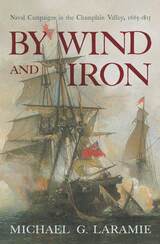 By Wind and Iron: Naval Campaigns in the Champlain Valley, 1665–1815
Michael Laramie
Westholme Publishing, 2015 Contested for More than a Century, a Natural Invasion Route into the Heart of North America
For more than 150 years, the natural invasion route along the waterways of the Champlain and Richelieu valleys into northeastern North America was among the most fiercely contested in the history of the continent. Whether the French and their Indian allies attacking British forts and settlements during the Seven Years’ War, the American Continentals striking north into Canada during the American Revolution, or the British battling French and later American forces in these wars and the War of 1812, it was clear to policy makers in Quebec, London, Paris, Philadelphia, and Washington that whoever controlled this corridor and its lakes and rivers, controlled the heart of the continent. In By Wind and Iron: Naval Campaigns in the Champlain Valley, 1665–1815, Michael G. Laramie details the maritime history of this region from the first French fortifications along the Richelieu River in the late seventeenth century through the tremendous American victory over the British at the Battle of Plattsburgh on Lake Champlain in 1814. Using period letters, journals, and other primary source materials, the author examines the northeastern waterways and their tributaries within the framework of the soldiers and sailors who faced the perils of the campaigns, while at the same time clarifying the key role played by this region in the greater struggle for North America and American independence.
In support of the narrative, the book also contains appendices that include after action reports from various fleet commanders, tables of fleet strengths, additional battle maps, a glossary, and a dictionary of lake warships with notes on vessel types, typical armament, construction, deployment, and fates.
By Words Alone: The Holocaust in Literature
Sidra DeKoven Ezrahi
University of Chicago Press, 1980 The creative literature that evolved from the Holocaust constitutes an unprecedented encounter between art and life. Those who wrote about the Holocaust were forced to extend the limits of their imaginations to encompass unspeakably violent extremes of human behavior. The result, as Ezrahi shows in By Words Alone, is a body of literature that transcends national and cultural boundaries and shares a spectrum of attitudes toward the concentration camps and the world beyond, toward the past and the future.
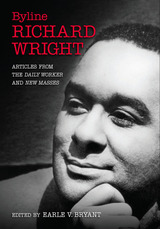 Byline, Richard Wright: Articles from the DAILY WORKER and NEW MASSES
Edited by Earle V. Bryant
University of Missouri Press, 2015 A writer perhaps best known for the revolutionary works Black Boy and Native Son, Richard Wright also worked as a journalist during one of the most explosive periods of the 20th century. From 1937 to 1938, Wright turned out more than two hundred articles for the Daily Worker, the newspaper that served as the voice of the American Communist Party. Byline, Richard Wright assembles more than one hundred of those articles plus two of Wright’s essays from New Masses, revealing to readers the early work of an American icon. As both reporter and Harlem bureau chief, Wright covered most of the major and minor events, personalities, and issues percolating through the local, national, and global scenes in the late 1930s. Because the Daily Worker wasn’t a mainstream paper, editors gave Wright free rein to cover the stories he wanted, and he tackled issues that no one else covered. Although his peers criticized his journalistic writing, these articles offer revealing portraits of Depression-era America rendered in solid, vivid prose. Featuring Earle V. Bryant’s informative, detailed introduction and commentary contextualizing the compiled articles, Byline, Richard Wright provides insight into the man before he achieved fame as a novelist, short story writer, and internationally recognized voice of social protest. This collection opens new territory in Wright studies, and fans of Wright’s novels will delight in discovering the lost material of this literary great.
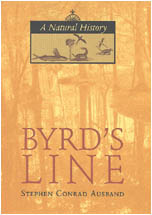 Byrd's Line: A Natural History
Stephen Conrad Ausband
University of Virginia Press, 2002 "[Ausband's] deep appreciation of the original accounts and his own obvious shared enthusiasm for the study of natural history inform this genial and engaging work throughout."
--Virginia Quarterly Review
In 1728, William Byrd, the wealthy, English-educated master of Westover plantation, undertook a journey with a troop of commissioners, surveyors, and woodsmen to determine the exact boundary between North Carolina and Virginia. Byrd was not only an indefatigable explorer but also an amateur naturalist and diarist of considerable skill. He recorded the journey in two classics of colonial literature--The History of the Dividing Line and The Secret History of the Line--which showcase in varying measure his keen observations of natural phenomena, his erudition, his predilection for exercise and sexual conquest, and his witty and elegant prose.
William Byrd and Stephen Ausband are separated by almost three hundred years, but they share a similar literary inclination complemented by an amateur interest in nature. Like Byrd, Ausband has tramped the dividing line and returned with a lively, informative book.
Byrd's Line is Ausband's dialogue with Byrd across the years. It still requires a hike or a four-wheel-drive vehicle to reach the remote beach where Byrd began his survey. As Ausband slogs through the Great Dismal Swamp and the thickets and forests that Byrd wrote about, he interlaces his own adventure with quotations from Byrd. These range from descriptions of chestnut trees and passenger pigeons, both gone now, to accounts of the local inhabitants, both native and European.
Byrd often mused about what would happen to the land in the future. While some of the dividing line still feels like wilderness, it is crisscrossed today by bridges and roads, its forests felled and paved over for parking lots and subdivisions, its waters diverted or drained. Ausband's story, therefore, is a natural history of a changed region. It is also an accessible introduction to the mind and words of an extraordinary early American.
--------------------------------------------------------------------------------
Stephen Conrad Ausband is Professor of English at Averett University. He is the author of Myth and Meaning, Myth and Order and of numerous articles for Virginia Wildlife and other publications.
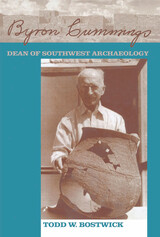 Byron Cummings: Dean of Southwest Archaeology
Todd W. Bostwick
University of Arizona Press, 2006 Byron Cummings, known to students and colleagues as “The Dean,” had a profound influence on the archaeology of Arizona and Utah during its early development. An explorer, archaeologist, anthropologist, teacher, museum director, university administrator, and state parks commissioner, Cummings was involved in many important discoveries in the American Southwest over the first half of the twentieth century and was a pioneer in the education of generations of archaeologists and anthropologists.
This book presents the first comprehensive examination of Cummings’ life, offering readers a greater understanding of his trailblazing work. Todd Bostwick elucidates Cummings’ many intellectual and cultural contributions, investigates the controversies in which he was embroiled, and describes his battles to wrest control of Arizona archaeology from eastern institutions that had long dominated Southwest archaeology.
Cummings saw the Southwest as an American wilderness where the story of cultural development revealed by the archaeologist and anthropologist was as important as it was in Europe. Bostwick’s meticulous account of his life reflects his great reverence for the region and pays tribute to a man whose dedication, mentoring, and friendship have forever sealed his place as The Dean.
 The Byronic Hero in Film, Fiction, and Television
Atara Stein
Southern Illinois University Press, 2004 The Byronic Hero in Film, Fiction, and Television bridges nineteenth- and twentieth-century studies in pursuit of an ambitious, antisocial, arrogant, and aggressively individualistic mode of hero from his inception in Byron’s Manfred, Childe Harold, and Cain, through his incarnations as the protagonists of Westerns, action films, space odysseys, vampire novels, neo-Gothic comics, and sci-fi television. Such a hero exhibits supernatural abilities, adherence to a personal moral code, ineptitude at human interaction (muddled even further by self-absorbed egotism), and an ingrained defiance of oppressive authority. He is typically an outlaw, most certainly an outcast or outsider, and more often than not, he is a he. Given his superhuman status, this hero offers no potential for sympathetic identification from his audience. At best, he provides an outlet for vicarious expressions of power and independence. While audiences may not seek to emulate the Byronic hero, Stein notes that he desires to emulate them; recent texts plot to “rehumanize” the hero or to voice through him approbation and admiration of ordinary human values and experiences. Tracing the influence of Lord Byron’s Manfred as outcast hero on a pantheon of his contemporary progenies—including characters from Pale Rider, Unforgiven, The Terminator, Alien, The Crow, Sandman, Star Trek: The Next Generation,and Angel—Atara Stein tempers her academic acumen with the insights of a devoted aficionado in this first comprehensive study of the Romantic hero type and his modern kindred. Atara Stein was a professor of English at California State University, Fullerton. Her articles on the development of the Byronic hero have appeared in Popular Culture Review, Romantic Circles Praxis Series, Genders, and Philological Quarterly.
 Byron's Letters and Journals
George Gordon Byron
Harvard University Press, 1973 George Gordon Byron was a superb letter-writer: almost all his letters, whatever the subject or whoever the recipient, are enlivened by his wit, his irony, his honesty, and the sharpness of his observation of people. They provide a vivid self-portrait of the man who, of all his contemporaries, seems to express attitudes and feelings most in tune with the twentieth century. In addition, they offer a mirror of his own time. This first collected edition of all Byron’s known letters supersedes Prothero’s incomplete edition at the turn of the century. It includes a considerable number of hitherto unpublished letters and the complete text of many that were bowdlerized by former editors for a variety of reasons. Prothero’s edition included 1,198 letters. This edition has more than 3,000, over 80 percent of them transcribed entirely from the original manuscripts.
The second volume of Byron’s letters embraces his second year in Greece, his revealing accounts to Hobhouse and others of his life in Athens, his visit to Veli Pasha, and his return by Malta to England. It covers the period of the loss of his mother and of several of his closest friends, of his first acquaintance with Moore and Rogers, his maiden speech in the House of Lords, the publication of Childe Harold, and the resulting fame that brought him into Whig society. It marks the beginning of his correspondence with Lady Melbourne, who became the confidante of his liaisons with Lady Caroline Lamb and Lady Oxford, and who forwarded his first (rejected) proposal to Annabella Milbanke.
Leslie A. Marchand, the author of critical studies and of the definitive biography of Byron, has brought a lifetime of study to the major task of editing these letters. He has done it with a restraint and objectivity that allows Byron to come through to us with unimpeded clarity.
 Byron's Letters and Journals
George Gordon Byron
Harvard University Press, 1979 George Gordon Byron was a superb letter-writer: almost all his letters, whatever the subject or whoever the recipient, are enlivened by his wit, his irony, his honesty, and the sharpness of his observation of people. They provide a vivid self-portrait of the man who, of all his contemporaries, seems to express attitudes and feelings most in tune with the twentieth century. In addition, they offer a mirror of his own time. This first collected edition of all Byron’s known letters supersedes Prothero’s incomplete edition at the turn of the century. It includes a considerable number of hitherto unpublished letters and the complete text of many that were bowdlerized by former editors for a variety of reasons. Prothero’s edition included 1,198 letters. This edition has more than 3,000, over 80 percent of them transcribed entirely from the original manuscripts.
The ninth volume in Leslie Marchand’s highly acclaimed, unexpurgated edition of Byron’s letters finds the poet in Pisa with Teresa Guiccioli. His unique journal, “Detached Thoughts,” is finished shortly after his arrival in November 1821, and he is drawn into Shelley’s circle (including Edward Williams, Thomas Medwin, John Taaffe, and later Trelawny). His letters to Mary Shelley, the Hunts, and Trelawny after the death of Shelley are especially moving. Another tragedy, the death of his daughter Allegra, leaves him deeply affected, and he refers to it time and time again.
Money problems continue to plague him, as do suspicions surrounding his political activities. Following a fracas with a half-drunken dragoon and the imprisonment of two of his servants because of it, Byron is forced to leave Pisa and install himself and Teresa in a villa near Leghorn. His correspondence with his publisher reveals increasing displeasure with Murray’s delays, indecision, and anxiety over Don Juan, and Byron finally breaks off the relationship. But his output of verse is in no way lessened, and by the end of this volume in 1822, he has finished six more cantos for Don Juan as well as other poems.
 Byron's Letters and Journals
George Gordon Byron
Harvard University Press, 1981 George Gordon Byron was a superb letter-writer: almost all his letters, whatever the subject or whoever the recipient, are enlivened by his wit, his irony, his honesty, and the sharpness of his observation of people. They provide a vivid self-portrait of the man who, of all his contemporaries, seems to express attitudes and feelings most in tune with the twentieth century. In addition, they offer a mirror of his own time. This first collected edition of all Byron’s known letters supersedes Prothero’s incomplete edition at the turn of the century. It includes a considerable number of hitherto unpublished letters and the complete text of many that were bowdlerized by former editors for a variety of reasons. Prothero’s edition included 1,198 letters. This edition has more than 3,000, over 80 percent of them transcribed entirely from the original manuscripts.
An enchanting epistolary saga ends with the publication of this volume. Volume XI: ‘For freedom’s battle’ contains the letters Byron wrote from Greece between August 1823 and April 9, 1824, ten days before his death. Also included are over fifty letters dating from 1807 to 1820 that have come to light since Leslie A. Marchand began this project ten years ago.
In the letters from Greece a new set of correspondents appears, and a new tone is apparent. Although occasionally playful, Byron is preoccupied with the revolution and his efforts to unite the Greeks in a common cause despite their discord. His chief correspondents are his business agents in the islands and his banker friend in Genoa, Charles Barry, to whom he writes frank accounts of daily affairs. His letters to Hobhouse and to John Bowring attempt to give a realistic picture of the Greek struggle. To Teresa Guiccioli he writes only short, dutiful postscripts in English to the longer letters addressed to her brother.
Among the additional letters that became available too late to take their chronological place in the earlier volumes are those discovered in 1976, locked in a trunk at Barclays Bank; all but one of these fourteen letters were written to Scrope Davies, Byron’s witty friend and drinking companion.
 Byron's Letters and Journals
George Gordon Byron
Harvard University Press, 1980 George Gordon Byron was a superb letter-writer: almost all his letters, whatever the subject or whoever the recipient, are enlivened by his wit, his irony, his honesty, and the sharpness of his observation of people. They provide a vivid self-portrait of the man who, of all his contemporaries, seems to express attitudes and feelings most in tune with the twentieth century. In addition, they offer a mirror of his own time. This first collected edition of all Byron’s known letters supersedes Prothero’s incomplete edition at the turn of the century. It includes a considerable number of hitherto unpublished letters and the complete text of many that were bowdlerized by former editors for a variety of reasons. Prothero’s edition included 1,198 letters. This edition has more than 3,000, over 80 percent of them transcribed entirely from the original manuscripts.
Byron’s brilliant epistolary saga approaches its end in this last full volume of his letters, from early October 1822 to his fateful departure for Greece in July 1823. During these months he was living in Genoa, with Teresa and her father and brother occupying an apartment in his house. Mary Shelley was staying with the Hunts in a house some distance away.
Byron enlarged his circle of English acquaintances, but his liveliest correspondence was still with John Murray, Kinnaird, Hobhouse, and Moore. Of special interest are his frank letters, half flirtatious, to Lady Hardy, those to Trelawny and Mary Shelley, and a growing number to Leigh Hunt and his brother John (publisher of The Liberal and of Byron’s poems after his break with Murray), discussing inter alia his thoughts about the continuation of Don Juan.
There is irony in Byron’s advice for a reconciliation between Webster and his wife Frances, whose matrimonial virtue Byron was proud to have spared in England. And there is pathos in his letters to his half-sister urging her and her children to join him in Italy, unaware that his missives to Augusta and her replies were scrutinized by Lady Byron. From April on, the letters are full of concern for support of the Greek forces and preparations for his departure.
 Byron's Letters and Journals
George Gordon Byron
Harvard University Press, 1976 George Gordon Byron was a superb letter-writer: almost all his letters, whatever the subject or whoever the recipient, are enlivened by his wit, his irony, his honesty, and the sharpness of his observation of people. They provide a vivid self-portrait of the man who, of all his contemporaries, seems to express attitudes and feelings most in tune with the twentieth century. In addition, they offer a mirror of his own time. This first collected edition of all Byron’s known letters supersedes Prothero’s incomplete edition at the turn of the century. It includes a considerable number of hitherto unpublished letters and the complete text of many that were bowdlerized by former editors for a variety of reasons. Prothero’s edition included 1,198 letters. This edition has more than 3,000, over 80 percent of them transcribed entirely from the original manuscripts.
In the fifth installment of this marvelous serial story, we read about Byron’s separation from his wife. Besides his pleading letters to Annabella asking her to reconsider, there are level-headed letters to Murray and Hobhouse and Hunt and Rogers—all written during the tempestuous time before his final departure from England. The accounts written during the ensuing summer, of Waterloo and the Rhine and Switzerland, reveal new depths of Byron’s maturing mind. But the very best letters here are the ones from Italy: freed from the inhibitions of English society, Byron’s spirit seems to expand and his letters reflect the joie de vivre that, despite his melancholy, was an inherent part of his character.
 Byron's Letters and Journals
George Gordon Byron
Harvard University Press, 1973 George Gordon Byron was a superb letter-writer: almost all his letters, whatever the subject or whoever the recipient, are enlivened by his wit, his irony, his honesty, and the sharpness of his observation of people. They provide a vivid self-portrait of the man who, of all his contemporaries, seems to express attitudes and feelings most in tune with the twentieth century. In addition, they offer a mirror of his own time. This first collected edition of all Byron’s known letters supersedes Prothero’s incomplete edition at the turn of the century. It includes a considerable number of hitherto unpublished letters and the complete text of many that were bowdlerized by former editors for a variety of reasons. Prothero’s edition included 1,198 letters. This edition has more than 3,000, over 80 percent of them transcribed entirely from the original manuscripts.
The first volume of Byron’s letters and journals covers his early years and includes his first pilgrimage to Greece and to the East, ending with his last letter from Constantinople on July 4, 1810, before his departure for Athens. Here is the direct record of his rapid development from the serious schoolboy to the facetious youth with ambivalent reactions to his perplexed mother, and the maturing man of extraordinary perceptions and sympathies and friendships. By the end of this volume he has already written English Bards and Scotch Reviewers (in part a spirited reaction to the reception of his earliest published work) and the first two Cantos of Childe Harold (published in 1812), which was to make him famous.
 Byron's Letters and Journals
George Gordon Byron
Harvard University Press, 1974 George Gordon Byron was a superb letter-writer: almost all his letters, whatever the subject or whoever the recipient, are enlivened by his wit, his irony, his honesty, and the sharpness of his observation of people. They provide a vivid self-portrait of the man who, of all his contemporaries, seems to express attitudes and feelings most in tune with the twentieth century. In addition, they offer a mirror of his own time. This first collected edition of all Byron’s known letters supersedes Prothero’s incomplete edition at the turn of the century. It includes a considerable number of hitherto unpublished letters and the complete text of many that were bowdlerized by former editors for a variety of reasons. Prothero’s edition included 1,198 letters. This edition has more than 3,000, over 80 percent of them transcribed entirely from the original manuscripts.
The third volume starts with Byron at the first crest of his fame following the publication of Childe Harold. It includes his literary letters to Tom Moore, frank and intimate ones to Hobhouse, pungent ones to Hanson and Murray, and his lively and amusing missives to Lady Melbourne, his confidante through all his love affairs. To her he describes the backwash of his tempestuous affair with Caroline Lamb, his emotional crises with Lady Oxford, the beginning of his liaison with his half-sister, Augusta Leigh, and his flirtation with Lady Frances Webster. The volume contains the letters of 1813 and the journal of 1813–1814, the first of his five incomparable journals.
The letters display, as Martin Fagg puts it, a “bewitching amalgam of the picturesque and the earthy, of arrogance and modesty, of vituperation and tenderness, of soulfulness and sheer irresistible high spirits.” They confirm Max Beerbohm’s opinion, “Byron’s letters are, I think, the best ever written—the fullest and most spontaneous.”
 Byron's Letters and Journals
George Gordon Byron
Harvard University Press, 1975 George Gordon Byron was a superb letter-writer: almost all his letters, whatever the subject or whoever the recipient, are enlivened by his wit, his irony, his honesty, and the sharpness of his observation of people. They provide a vivid self-portrait of the man who, of all his contemporaries, seems to express attitudes and feelings most in tune with the twentieth century. In addition, they offer a mirror of his own time. This first collected edition of all Byron’s known letters supersedes Prothero’s incomplete edition at the turn of the century. It includes a considerable number of hitherto unpublished letters and the complete text of many that were bowdlerized by former editors for a variety of reasons. Prothero’s edition included 1,198 letters. This edition has more than 3,000, over 80 percent of them transcribed entirely from the original manuscripts.
In this volume, Byron corresponds with writers such as Thomas Moore, Coleridge, Leigh Hunt, and “Monk” Lewis; with John Murray about the publication of The Corsair, Lara, and The Hebrew Melodies; and with many personal friends. A new interest is his association with the Drury Lane Theater. The crucial events of his private life at this time are his engagement to Anabella Milbanke and their marriage early in 1815—a marriage that was to last little more than a year. Especially revelatory are his letters to his fiancée and those to his long-time confidante, Lady Melbourne.
Volume IV includes all the letters from the beginning of 1814 to the end of 1815.
 Byron's Letters and Journals
George Gordon Byron
Harvard University Press George Gordon Byron was a superb letter-writer: almost all his letters, whatever the subject or whoever the recipient, are enlivened by his wit, his irony, his honesty, and the sharpness of his observation of people. They provide a vivid self-portrait of the man who, of all his contemporaries, seems to express attitudes and feelings most in tune with the twentieth century. In addition, they offer a mirror of his own time. This first collected edition of all Byron’s known letters supersedes Prothero’s incomplete edition at the turn of the century. It includes a considerable number of hitherto unpublished letters and the complete text of many that were bowdlerized by former editors for a variety of reasons. Prothero’s edition included 1,198 letters. This edition has more than 3,000, over 80 percent of them transcribed entirely from the original manuscripts.
Byron’s epistolary saga continues con brio in this volume. At the start of 1818 he sends off the last canto of Childe Harold and abandons himself to the debaucheries of the Carnival in Venice. At the close of 1819 he resolves to return to England but instead follows Teresa Guiccioli to Ravenna. In the meantime he writes three long poems and two cantos of Don Juan, whose bowdlerization he violently protests; he breaks off with Marianna Segati, copes with his amorous “tigress” Margarita Cogni, then falls passionately in love with the young Countess Guiccioli; he thinks seriously of emigrating to South America; he takes custody of his little daughter Allegra and becomes increasingly fond of the child. The Shelleys visit him, as does Thomas Moore, to whom he entrusts his memoirs (burned after his death). The letters to friends are a marvelous outpouring of funny anecdotes, practical talk, discussions of his poems, statements of his beliefs. The love letters are in a class by themselves.
Byron's Letters and Journals
George Gordon Byron
Harvard University Press, 1977 Byron’s letters provide a vivid self-portrait of the man who, of all his contemporaries, seems to express attitudes and feelings most in tune with the twentieth century. Readers and reviewers have responded with great enthusiasm to Leslie Marchand's new unexpurgated edition.
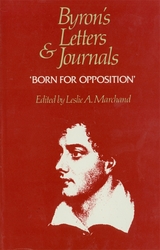 Byron's Letters and Journals
George Gordon Byron
Harvard University Press, 1978 George Gordon Byron was a superb letter-writer: almost all his letters, whatever the subject or whoever the recipient, are enlivened by his wit, his irony, his honesty, and the sharpness of his observation of people. They provide a vivid self-portrait of the man who, of all his contemporaries, seems to express attitudes and feelings most in tune with the twentieth century. In addition, they offer a mirror of his own time. This first collected edition of all Byron’s known letters supersedes Prothero’s incomplete edition at the turn of the century. It includes a considerable number of hitherto unpublished letters and the complete text of many that were bowdlerized by former editors for a variety of reasons. Prothero’s edition included 1,198 letters. This edition has more than 3,000, over 80 percent of them transcribed entirely from the original manuscripts.
Born for Opposition opens with Byron in Ravenna, in 1821. His passion for the Countess Guiccioli is subsiding into playful fondness, and he confesses to his sister Augusta that he is not “so furiously in love as at first.” Italy, meanwhile, is afire with the revolutionary activities of the Carbonari, which Byron sees as “the very poetry of politics.” His journal, written while the insurrection grew, is a remarkable record of his reading and reflections while awaiting the sounds of gunfire. In spite of the turmoil, Byron stuck fast to his work. By the end of this volume, in October 1821, he is established in Pisa, having written Sardanapalus, Cain, and The Vision of Judgement.
 Byron's Letters and Journals
George Gordon Byron
Harvard University Press, 1982 George Gordon Byron was a superb letter-writer: almost all his letters, whatever the subject or whoever the recipient, are enlivened by his wit, his irony, his honesty, and the sharpness of his observation of people. They provide a vivid self-portrait of the man who, of all his contemporaries, seems to express attitudes and feelings most in tune with the twentieth century. In addition, they offer a mirror of his own time. This first collected edition of all Byron’s known letters supersedes Prothero’s incomplete edition at the turn of the century. It includes a considerable number of hitherto unpublished letters and the complete text of many that were bowdlerized by former editors for a variety of reasons. Prothero’s edition included 1,198 letters. This edition has more than 3,000, over 80 percent of them transcribed entirely from the original manuscripts.
The final volume of this splendid edition contains a comprehensive index to the contents of the preceding volumes—the several thousand letters, the journals, the notes and biographical sketches. The index is prefaced by a generous selection of Byron’s aphorisms, bons mots, and memorable statements, culled by Leslie Marchand from the letters and journals and arranged under subject headings.
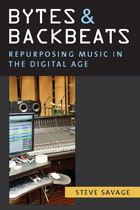 Bytes and Backbeats: Repurposing Music in the Digital Age
Steve Savage
University of Michigan Press, 2013 From Attali's "cold social silence" to Baudrillard's hallucinatory reality, reproduced music has long been the target of critical attack. In Bytes and Backbeats, however, Steve Savage deploys an innovative combination of designed recording projects, ethnographic studies of contemporary music practice, and critical analysis to challenge many of these traditional attitudes about the creation and reception of music. Savage adopts the notion of "repurposing" as central to understanding how every aspect of musical activity, from creation to reception, has been transformed, arguing that the tension within production between a naturalizing "art" and a self-conscious "artifice" reflects and feeds into our evolving notions of creativity, authenticity, and community. At the core of the book are three original audio projects, drawing from rock & roll, jazz, and traditional African music, through which Savage is able to target areas of contemporary practice that are particularly significant in the cultural evolution of the musical experience. Each audio project includes a studio study providing context for the social and cultural analysis that follows. This work stems from Savage's experience as a professional recording engineer and record producer.
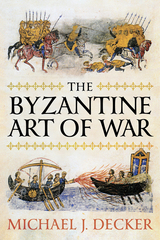 The Byzantine Art of War
Michael J. Decker
Westholme Publishing, 2013 A Complete Overview of One of the Most Important Military Forces in the History of the World
The Byzantine Art of War explores the military history of the thousand-year empire of the eastern Mediterranean, Byzantium. Throughout its history the empire faced a multitude of challenges from foreign invaders seeking to plunder its wealth and to occupy its lands, from the deadly Hunnic hordes of Attila, to the Arab armies of Islam, to the western Crusaders bent on carving out a place in the empire or its former lands. In order to survive the Byzantines relied on their army that was for centuries the only standing, professional force in Europe. Leadership provided another key to survival; Byzantine society produced a number of capable strategic thinkers and tacticians—and several brilliant ones. These officers maintained a level of professionalism and organization inherited and adapted from Roman models. The innovations of the Byzantine military reforms of the sixth century included the use of steppe nomad equipment and tactics, the most important of which was the refinement of the Roman mounted archer. Strategy and tactics evolved in the face of victory and defeat; the shock of the Arab conquests led to a sharp decline in the number and quality of imperial forces. By the eighth and ninth centuries Byzantine commanders mastered the art of the small war, waging guerrilla campaigns, raids, and flying column attacks that injured the enemy but avoided the decisive confrontation the empire was no longer capable of winning. A century later they began the most sustained, glorious military expansion of their history. This work further sketches the key campaigns, battles, and sieges that illustrate Byzantine military doctrine, vital changes from one era to another, the composition of forces and the major victories and defeats that defined the territory and material well-being of its citizens. Through a summary of their strategies, tactics, and innovations in the tools of war, the book closes with an analysis of the contributions of this remarkable empire to world military history.
Byzantine Coinage
Philip Grierson
Harvard University Press, 1999 This introductory booklet on Byzantine coinage, first published in 1982, has been updated and expanded to include a description of the creation of the coin collection at Dumbarton Oaks. This new edition marks the completion of the five volume series Catalogue of the Byzantine Coins in the Dumbarton Oaks Collection.
The booklet covers phases of the coinage, gold, silver, and copper coinage, types and inscriptions, and ruler representations. Tables of values corresponding with various times in the empire’s history, a list of Byzantine emperors, and a glossary are also provided.
Byzantine Coins
George E. Bates
Harvard University Press, 1971 During the summers from 1958 through 1968 a Harvard-Cornell team of archeologists excavated the site of ancient Sardis, metropolis of Asia Minor and fabled capital of the Lydian Kingdom. Byzantine Coins is the first volume in a series of reports and monographs in which the results of these excavations will be published. George Bates provides a catalogue of 1,234 coins and one seal dating from A.D. 491 to 1282. His monograph meticulously describes each coin and contains sharply detailed reproductions of the 121 best preserved coins as well as maps of the area and notes which describe where each coin was found.
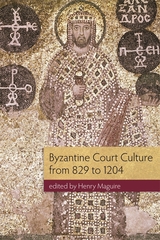 Byzantine Court Culture from 829 to 1204
Henry Maguire
Harvard University Press, 1997 The imperial court in Constantinople has been central to the outsider’s vision of Byzantium. However, in spite of its fame in literature and scholarship, there have been few attempts to analyze the Byzantine court in its entirety as a phenomenon. The studies in this volume aim to provide a unified composition by presenting Byzantine courtly life in all its interconnected facets.
One important theme that unites these studies is the attention paid to describing the effects of a change in the social makeup of the court during this period and the reflection of these changes in art and architecture. These changes in social composition, mentality, and material culture of the court demonstrate that, as in so many other aspects of Byzantine civilization, the image of permanence and immutability projected by the forms of palace life was more apparent than real. As this new work shows, behind the golden facade of ceremony, rhetoric, and art, there was constant development and renewal.
Byzantine Defenders of Images: Eight Saints' Lives in English Translation
Alice-Mary Talbot
Harvard University Press, 1998 Byzantine Defenders of Images introduces saints who were active during the period of the iconoclastic controversy in Byzantium (726–843). For almost a century and a half, theological and popular opinions were strongly divided on the question of the manufacture and veneration icons of Christ, the Virgin, and saints. The seven vitae feature holy men and women who opposed imperial edicts and suffered for their defense of images, from the nun Theodosia whose efforts to save the icon of Christ Chalkites made her the first iconodule martyr, to Symeon of Lesbos, the pillar saint whose column was attacked by religious fanatics.
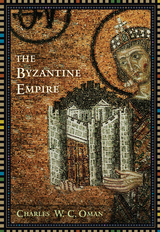 The Byzantine Empire
Charles W. C. Oman
Westholme Publishing, 2009 The Byzantine Empire centered at the city of Constantinople grew from a small Greek colonial village into the capital of the Eastern Roman empire. Ultimately, Byzantium represented what remained of Roman power in late antiquity. Established as the seat of Constantine the Great in 328 AD, the empire grew and matured over the centuries, reaching its pinnacle in the sixth century during the reign of Justinian and his loyal general, Belisarius. In the process of empire building, Byzantium battled the Goths, the Germanic tribes, the Persians, the Lombards, and ultimately the Islamic armies of the Near East. Byzantium remained a buffer against Muslim expansion, and by the time the remnants of the empire and the city of Constantinople were finally conquered by the Ottomans in the fourteenth century, European states to the west were able to resist any further encroachment. In tracing the empire’s history from its humble beginnings through its ascendancy and final decay, distinguished historian Charles W. C. Oman blends his engaging narrative style with his impeccable command of primary source material. Here, Oman dispels the misconception that the Byzantine court was one plagued by corruption and intrigue—a canard that added “Byzantine” to the English language; instead, Byzantium was one of the most stable governments of late antiquity. Never before reprinted in paperback, The Byzantine Empire is a model of concise popular scholarship.
The Byzantine Empire (Revised Edition)
Robert Browning
Catholic University of America Press, 1992 This classic study presents the history of the Byzantine Empire from the sixth to the fifteenth century in terms of political events, art, literature, and thought. It is addressed to the general reader of history as well as to students and scholars.
Byzantine Figural Processional Crosses
John Cotsonis
Harvard University Press, 1994 Scarcely any object was as ubiquitous in Byzantine culture as the cross. This exhibition catalogue focuses on the figural processional cross, and the examples here provide opportunity to consider the various functions such crosses served in the imperial, ecclesiastic, military, and private sphere for both men and women.
Byzantine Garden Culture
Antony Littlewood, Henry Maguire, and Joachim Wolschke-Bulmahn
Harvard University Press, 2002 Only in the last decade has much serious attention been paid to the Byzantine garden, so indirect is the mass of information, both in literature and the visual arts, that is available for scholars. Byzantine Garden Culture, based on papers delivered at a colloquium at Dumbarton Oaks, is the first book devoted to the subject.
Individual essays discuss Byzantine conceptions of paradise, the textual evidence for monastic horticulture, animal and game parks, herbs in medicinal pharmacy, and the famous illustrated copy of Dioskorides’s herbal manual in Vienna. An opening chapter explores questions and observations from the point of view of a non-Byzantine garden historian, and the closing chapter suggests possible directions for future scholarship in the field.
Byzantine Gender
Leonora Neville
Arc Humanities Press, 2019 <div>Why were virtuous Byzantine women described as manly? Why were boys' bodies thought to be closer in constitution to those of women than adult men? Did Byzantines think eunuchs were men? </div><div>This lively and personal book explains some key aspects of how people of the Medieval Roman Empire (Byzantine Empire) conceived of men and women, masculinity and femininity, and proper behaviour for men and women. By laying bare fundamental ideas about how gender was defined and performed, <i>Byzantine Gender</i> enables readers to understand Byzantine society more fully. And by providing background information about Byzantine gender, it makes it easier to approach and appreciate the fascinating otherness of Byzantine culture.</div>
Byzantine Magic
Henry Maguire
Harvard University Press, 1995 Written by specialists in several disciplines, this volume explores the parameters and significance of magic in Byzantine society, from the fourth century to after the empire's fall. The authors address a wide variety of questions, some of which are common to all historical research into magic, and some of which are peculiar to the Byzantine context.
The authors reveal the scope, the forms, and the functioning of magic in Byzantine society, throwing light on a hitherto relatively little-known aspect of Byzantine culture, and, at the same time, expanding upon the contemporary debates concerning magic and its roles in pre-modern societies.
Byzantine Monastic Foundation Documents: A Complete Translation of the Surviving Founders' Typika and Testaments
John Philip Thomas
Harvard University Press, 2000 The nature of the typkia, discussed by John Thomas in the introduction, was one of flexible and personal documents, which differed considerably in form, length, and content. Not all of them were foundation documents in the strict sense, since they could be issued at any time in the history of an institution. Some were wills; others were reform decrees and rules; yet others were primarily liturgical in character.
A Byzantine Monastic Office, A.D. 1105
Jeffrey C. Anderson
Catholic University of America Press, 2016 This book centers on a Greek text that was likely compiled in Constantinople, in 1105, for use in one of the monasteries located there. The book is a liturgical psalter, containing the fixed structure (the ordinary) in both the Greek original and in English translation, as well as a description of the hours themselves. The extensive commentary explains the development of the monastic office, and the particular history of the translated manuscript, while brief notes clarify and explain, in a way suitable for non-liturgists, the more-technical aspects of the offices.
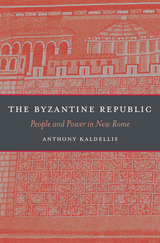 The Byzantine Republic: People and Power in New Rome
Anthony Kaldellis
Harvard University Press, 2015 Although Byzantium is known to history as the Eastern Roman Empire, scholars have long claimed that this Greek Christian theocracy bore little resemblance to Rome. Here, in a revolutionary model of Byzantine politics and society, Anthony Kaldellis reconnects Byzantium to its Roman roots, arguing that from the fifth to the twelfth centuries CE the Eastern Roman Empire was essentially a republic, with power exercised on behalf of the people and sometimes by them too. The Byzantine Republic recovers for the historical record a less autocratic, more populist Byzantium whose Greek-speaking citizens considered themselves as fully Roman as their Latin-speaking “ancestors.”
Kaldellis shows that the idea of Byzantium as a rigid imperial theocracy is a misleading construct of Western historians since the Enlightenment. With court proclamations often draped in Christian rhetoric, the notion of divine kingship emerged as a way to disguise the inherent vulnerability of each regime. The legitimacy of the emperors was not predicated on an absolute right to the throne but on the popularity of individual emperors, whose grip on power was tenuous despite the stability of the imperial institution itself. Kaldellis examines the overlooked Byzantine concept of the polity, along with the complex relationship of emperors to the law and the ways they bolstered their popular acceptance and avoided challenges. The rebellions that periodically rocked the empire were not aberrations, he shows, but an essential part of the functioning of the republican monarchy.
Byzantine Rome
Annie Montgomery Labatt
Arc Humanities Press, 2022 Why does medieval Rome look so, for lack of a better word, Byzantine? Why do its monuments speak an aesthetic of the medieval East? And just how do we quantify that Byzantine aesthetic or even the word “Byzantine”? This book seeks to consider the ways in which the artistic styles and iconographies generally associated with the eastern medieval tradition had a life in the West and, in many cases, were just as western as they were eastern. Rome’s medieval monuments are a fundamental part of the history of the East, a history that says more about a cross- cultural exchange and interconnected “Romes” than difference and separation. Each chapter follows the political and theological relationships between the East and the West chronologically, exploring the socio-political exchanges as they manifest in the visual language of the monuments that defined the medieval landscape of Rome.
A Byzantine Settlement in Cappadocia
Robert G. Ousterhout
Harvard University Press, 2005 Based on four seasons of fieldwork, this book presents the results of the first systematic site survey of a region rich in material remains. From architecture to fresco painting, Cappadocia represents a previously untapped resource for the study of material culture and the settings of daily life within the Byzantine Empire.
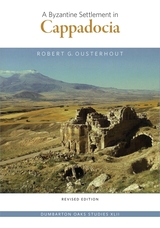 A Byzantine Settlement in Cappadocia: Revised Edition
Robert G. Ousterhout
Harvard University Press, 2011 Following its initial publication in 2005, A Byzantine Settlement in Cappadocia has become a seminal work in interpreting the rich material remains of Byzantine Cappadocia. In the first systematic site survey from the region, at the settlement known as Çanlı Kilise in Western Cappadocia, the careful mapping and documentation of rock-cut and masonry architecture and its decoration led to a complete reexamination of the place of Cappadocia within the larger framework of Byzantine social and cultural developments. This revised edition builds upon its predecessor with an updated preface, a new bibliography, and a new master map of the Çanlı Kilise site.
Based on four seasons of fieldwork, Ousterhout challenges the commonly accepted notion that the rock-cut settlements of Cappadocia were primarily monastic. He proposes instead that the settlement at Çanlı Kilise was a town, replete with mansions, hovels, barns, stables, storerooms, cisterns, dovecotes, wine presses, fortifications, places of refuge, churches, chapels, cemeteries, and a few monasteries—that is, features common to most Byzantine communities. A Byzantine Settlement in Cappadocia has led to a rethinking of such sites and to a view of Cappadocia as an untapped resource for the study of material culture and daily life within the Byzantine Empire.
 The Byzantine Shops at Sardis
J. Stephens Crawford
Harvard University Press, 1990 The Byzantine Shops at Sardis form a complex of commercial establishments lining the south wall of Sardis's renowned synagogue and bath complex. They offer scholars a unique opportunity to study urban life and commercial architecture in the Late Antique period. Remarkably well preserved, these shops provide economic data vital to an understanding of the trade and commerce of their time.
J. Stephens Crawford was a primary excavator of the shops and has worked at contemporary sites in Asia Minor. His first-hand insights elucidate his publication of the functions of the shops, which include dye shops, glass shops, a “hardware store,” and a restaurant. Crawford explores the evidence of religious diversity in the shops, where Jews and Christians lived and worked side by side. The contributors to this volume include Martha Goodway, George M. A. Hanfmann, Jane Ayer Scott, Pamela Vandiver, and Michael Weishan. Descriptions of the finds, which are extensively illustrated, are contributed by J. A. Scott. A comprehensive chapter of architectural comparanda from Asia Minor, Greece, Egypt, and the Near East presents some interesting parallels. Pamela Vandiver and Martha Goodway of the Smithsonian Conservation Laboratory provide an appendix of analyses of metal and fruit residues from the crucibles found in the shops, and a numismatic appendix summarizes the currency by mint.
 The Byzantine Sinbad
Michael Andreopoulos
Harvard University Press, 2021 The Byzantine Sinbad collects The Book of Syntipas the Philosopher and The Fables of Syntipas, both translated from Syriac in the late eleventh century by the scholar Michael Andreopoulos.
Originally written in Persian and part of a multilingual and multicultural medieval storytelling tradition, The Book of Syntipas recounts how the Persian king Cyrus’s unnamed son—a student of the fictional philosopher Sinbad, who is known in Greek as Syntipas—is falsely accused of rape by a royal concubine. While the young man awaits execution, seven philosophers and the concubine attempt to influence Cyrus’s judgment. After seven days of storytelling, the son is exonerated and demonstrates the wisdom he learned from Syntipas.
The sixty-two moral tales in The Fables of Syntipas are inspired mainly by the tradition of Aesop but include fifteen that are uniquely attributed to the philosopher.
This volume is the first English translation to bring together Andreopoulos’s Byzantine Greek texts.
 Byzantine Slavery and the Mediterranean World
Youval Rotman
Harvard University Press, 2009 Slavery may no longer exist as a legal institution, but we still find many forms of non-freedom in contemporary societies. It is a troubling paradox, and one this book addresses by considering a period in which the definition of slavery and freedom proved considerably flexible. Between more familiar forms of slavery—those of antiquity and of the Americas—the institution as it was practiced and theorized in the Byzantine Mediterranean was of a different nature.
Looking at the Byzantine concept of slavery within the context of law, the labor market, medieval politics, and religion, Youval Rotman illustrates how these contexts both reshaped and sustained the slave market. By focusing on a period of great change, his historical analysis brings a new perspective to concepts of slavery and freedom. In this period, when Byzantium had to come to terms with the rising power of the Islamic state, and to fight numerous wars over territory and economic interests, Rotman traces a shift in the cultural perception of slaves as individuals: they began to be seen as human beings instead of private property. His book analyzes slavery as a historical process against the background of the political, social, and religious transformation of the Mediterranean world, and demonstrates the flexible and adaptable character of this institution.
Arguing against the use of the term “slavery” for any extreme form of social dependency, Rotman shows instead that slavery and freedom are unrelated concepts. His work offers a radical new understanding of the geopolitical and religious dynamics that have defined and redefined slavery and freedom, in the past and in our own time.
The Byzantines
Edited by Guglielmo Cavallo
University of Chicago Press, 1997 For more than a thousand years, Byzantium flourished at the crossroads of the Eastern and Western worlds. But who were the people of the first modern civilized state? What features distinguished them from earlier civilizations, and what cultural characteristics, despite their multi-ethnic origins, made them uniquely Byzantine?
Through a series of remarkably detailed composite portraits, an international collection of distinguished scholars has created a startlingly clear vision of the Byzantines and their social world. Paupers, peasants, soldiers, teachers, bureaucrats, clerics, emperors, and saints—all are vividly and authentically presented in the context of ordinary Byzantine life. No comparable volume exists that so fascinatingly recovers from the past the men and women of Byzantium, their culture and their lifeways, and their strikingly modern worldview.
Byzantium
Rowena Loverance
Harvard University Press, 1988
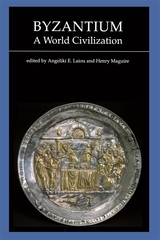 Byzantium, a World Civilization
Angeliki E. Laiou
Harvard University Press, 1992 This book introduces the great civilization of Byzantium and shows the centrality of Byzantium’s role in world history. It also celebrates the founding by Robert Woods Bliss and Mildred Bliss of one of the major institutions devoted to the study of that civilization, the Byzantine Center at Dumbarton Oaks in Washington, D.C.
Through seven interrelated chapters, which were originally given as lectures at two meetings held in Washington in 1990 and 1991 to honor the fiftieth anniversary of Dumbarton Oaks, the contributors demonstrate the place of Byzantine civilization in world history—both Eastern and Western. At the same time, they show the place of Dumbarton Oaks in interpreting that civilization for what its founders called “an everchanging present.”
The first essay, written by Milton Anastos, a scholar who first came to Dumbarton Oaks in 1941, one year after the founding of the Byzantine Center, is devoted to the institution itself and to the role that it has played in Byzantine Studies over the past fifty years. The four following chapters, by Speros Vryonis, Dimitri Obolensky, Irfan Shahîd, and Angeliki Laiou, discuss the relationships between Byzantium and its neighboring civilizations, Islamic, Slavic, and Western European, and display the great legacy that Byzantium left to those cultures. The two final essays, by Gary Vikam and Henry Maguire, present Byzantine art, today the best known aspect of Byzantine achievement, and discuss its reception by modern critics and historians.
 Byzantium after the Nation: The Problem of Continuity in Balkan Historiographies
Dimitris Stamatopoulos
Central European University Press, 2023 Stamatopoulos undertakes the first systematic comparison of the dominant ethnic historiographic models and divergences elaborated by Greek, Bulgarian, Serbian, Albanian, Romanian, Turkish, and Russian intellectuals with reference to the ambiguous inheritance of Byzantium. The title alludes to the seminal work of Nicolae Iorga in the 1930s, Byzantium after Byzantium, that argued for the continuity between the Byzantine and the Ottoman empires. Rival Balkan nationalisms engaged in a “war of interpretation” as to the nature of Byzantium, assuming different positions of adoption or rejection of its imperial model and leading to various schemes of continuity in each national historiographic canon. Stamatopoulos discusses what Byzantium represented for nineteenth-, and twentieth-century scholars and how their perceptions related to their treatment of the imperial model: whether a different perception of the medieval Byzantine period prevailed in the Greek national center as opposed to Constantinople; how nineteenth-century Balkan nationalists and Russian scholars used Byzantium to invent their own medieval period (and, by extension, their own antiquity); and finally, whether there exist continuities or discontinuities in these modes of making ideological use of the past.
 Byzantium and the Arabs in the Fifth Century
Irfan Shahîd
Harvard University Press, 1989 Just as the Tanūkhids rose and fell as the principal Arab foederati of Byzantium in the fourth century, so too in the fifth did the Salīḥids. The century, practically terra incognita in the history of Arab-Byzantine relations, is explored in Byzantium and the Arabs in the Fifth Century by Irfan Shahîd, who recovers from the sources the political, military, ecclesiastical, and cultural history of the Arab foederati in Oriens and the Arabian Peninsula during this period. Unlike their predecessors or successors, the foederati of the fifth century lived in perfect harmony with Byzantium. Federate-imperial relations were smooth: the Arab horse reached as far as Pentapolis in the West and possibly took part in Leo’s expedition against the Vandals. They were staunchly orthodox and participated in two ecumenical councils, Ephesus and Chalcedon, where their voice was audible. But their more enduring contributions were cultural, and may be associated with Dāwūd (David), the Salīḥid king; Petrus, the bishop of the Parembole; and possibly also Elias, patriarch of Jerusalem (494–516), a Roman Arab. The federate culture gave impetus to the rise of the Arabic script, Arabic poetry, and a simple form of an Arabic liturgy—the foundation for cultural achievements in subsequent centuries.
 Byzantium and the Arabs in the Fourth Century
Irfan Shahîd
Harvard University Press, 1984 The fourth century, the century of Constantine, witnessed the foundation and rise of a new relationship between the Roman Empire and the Arabs. The warrior Arab groups in Oriens became foederati, allies of Byzantium, the Christian Roman empire, and so they remained until the Arab conquests. In Byzantium and the Arabs in the Fourth Century, Irfan Shahîd elucidates the birth of the new federate existence and the rise of its institutional forms and examines the various constituents of federate cultural life: the phylarchate, the episcopate, the beginnings of an Arab Church, an Arabic liturgy, and the earliest attested composition of Arabic poetry. He discusses the participation of the Arab foederati in Byzantium’s wars with neighboring Persians and Goths during which those Arab allies, most notably the Tanūkhids, contributed to the welfare of the imperium and the ecclesia. The Arab federate horse galloped for Byzantium as far as Ctesiphon, Constantinople, and possibly Najrân in Arabia Felix. In the reign of Valens, the foederati appeared as the defenders of Nicene Orthodoxy: their soldiers fought for it; their stern and uncompromising saint, Moses, championed it; and their heroic and romantic queen, Mavia, negotiated for it.
Byzantium and the Arabs in the Sixth Century
Irfan Shahîd
Harvard University Press, 1995 Byzantium and the Arabs in the Sixth Century, Volume 2, Part 1: Toponymy, Monuments, Historical Geography, and Frontier Studies is a topical study of the military, religious, and civil structures of the Ghassanids. Irfan Shahîd’s detailed study of Arab buildings of the sixth century illuminates how Byzantine provincial art and architecture were adopted and adapted by the federate Arabs for their own use. As monuments of Christian architecture, these federate structures constitute the missing link in the development of Arab architecture in the region between the earlier pagan (Nabataean and Palmyrene) and later Muslim (Umayyad) styles. Drawing from literary and material evidence, Shahîd argues that the Ghassanids were not nomadic, as traditionally believed, but thoroughly sedentary both in their roots and in the late Roman frontier zone they inherited.
Byzantium and the Arabs in the Sixth Century
Irfan Shahîd
Harvard University Press Byzantium and the Arabs in the Sixth Century, Volume 2, Part 2: Economic, Social, and Cultural History reveals the history of a fully developed and unique Christian Arab culture, the Ghassanids, in the sixth century. Irfan Shahîd covers the Ghassanid economy, including trade routes and fairs, and reconstructs Ghassanid daily life, discussing topics as varied as music, food, medicine, the role of women, and horse racing. Shahîd examines cultural life, including descriptions of urbanization, Arabic script, chivalry, and poetry. Shahîd describes the society of the Ghassanids and their contributions to the cultural environment in Oriens during the sixth century and into the Umayyad caliphate.
Byzantium and the Arabs in the Sixth Century
Irfan Shahîd
Harvard University Press Byzantium and the Arabs in the Sixth Century, Volume 1, Part 1: Political and Military History is devoted to the main Arabian tribes that were federates of the Byzantine Roman Empire. In the early sixth century, Constantinople shifted its Arab alliance from the Salīḥids to the Kindites and especially the Ghassanids, who came to dominate Arab-Byzantine relations through the reign of Heraclius. Arranged chronologically, this study, the first in-depth account of the Ghassanids since the nineteenth century, draws widely from original sources in Greek, Syriac, and Arabic. Irfan Shahîd traces in detail the vicissitudes of the relationship between the Romans and the Ghassanids, and argues for the Ghassanid’s extensive role in the defense of the Byzantine Empire in the east.
Byzantium and the Arabs in the Sixth Century
Irfan Shahîd
Harvard University Press Byzantium and the Arabs in the Sixth Century, Volume 1, Part 2: Ecclesiastical History provides a chronologically ordered account of the involvement of the Ghassanids in ecclesiastical affairs in the eastern region of the Byzantine Empire. Tracing the role of Arab tribes both inside and outside the Roman limes, Irfan Shahîd documents how the Ghassanids, in particular, came to establish and develop a distinct non-Chalcedonian church hierarchy while remaining allies with the Chalcedonian emperors. Ghassanid phylarchs such as Mundir emerge not merely as loyal foederati but as devout Christians. Shahîd extensively and critically analyzes the Greek, Syriac, and Arabic sources, including many obscure or unfamiliar texts, to illuminate the religious landscape of the Arabs of the sixth century.
Byzantium and the Arabs in the Sixth Century
Irfan Shahîd
Harvard University Press Byzantium and the Arabs in the Sixth Century, Volume 2, Part 1: Toponymy, Monuments, Historical Geography, and Frontier Studies is a topical study of the military, religious, and civil structures of the Ghassanids. Irfan Shahîd’s detailed study of Arab buildings of the sixth century illuminates how Byzantine provincial art and architecture were adopted and adapted by the federate Arabs for their own use. As monuments of Christian architecture, these federate structures constitute the missing link in the development of Arab architecture in the region between the earlier pagan (Nabataean and Palmyrene) and later Muslim (Umayyad) styles. Drawing from literary and material evidence, Shahîd argues that the Ghassanids were not nomadic, as traditionally believed, but thoroughly sedentary both in their roots and in the late Roman frontier zone they inherited.
Byzantium and the Arabs in the Sixth Century
Irfan Shahîd
Harvard University Press Byzantium and the Arabs in the Sixth Century, Volume 2, Part 2: Economic, Social, and Cultural History reveals the history of a fully developed and unique Christian Arab culture, the Ghassanids, in the sixth century. Irfan Shahîd covers the Ghassanid economy, including trade routes and fairs, and reconstructs Ghassanid daily life, discussing topics as varied as music, food, medicine, the role of women, and horse racing. Shahîd examines cultural life, including descriptions of urbanization, Arabic script, chivalry, and poetry. Shahîd describes the society of the Ghassanids and their contributions to the cultural environment in Oriens during the sixth century and into the Umayyad caliphate.
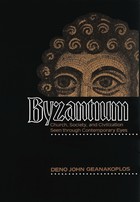 Byzantium: Church, Society, and Civilization Seen through Contemporary Eyes
Deno John Geanakoplos
University of Chicago Press, 1984 Deno John Geanakoplos here offers a prodigious collection of source materials on the Byzantine church, society, and civilization (many translated for the first time into English), arranged chronologically and topically, and knit together with an analytical historical commentary. His selections from Byzantine writers as well as from more obscure documents and chronicles in Latin, Arabic, Slavic, Italian, Armenian, and French reflect all the diversity of Byzantine life—the military tactics of the long-invincible cataphract cavalry and the warships armed with Greek fire, the mysticism of Hesychast monks, the duties of imperial officers, the activities of daily life from the Hippodrome and Hagia Sophia to the marketplaces, baths, and brothels. Geanakoplos not only covers the traditional areas of political, ecclesiastical, socioeconomic, administrative, and military life, but also provides a vivid picture of Byzantine culture—education, philosophy, literature, theology, medicine, and science. Of particular interest are the insights into the empire's relations with the Latin West, the Slavs, the Arabs, the Turks, and other neighboring peoples.
Byzantium is much more than a sourcebook. The running commentary reflects the most recent scholarly research in Byzantine studies and places each translated source in its precise historical context. Through the use of both primary sources and commentary, Geanakoplos has represented in all its richness and complexity one of the world's great civilizations. There is no comparable book on Byzantine history and civilization in any language.
Byzantium: Revised Edition
Rowena Loverance
Harvard University Press The earthly empire of Byzantium dominated the political and religious history of Europe for over a thousand years. The Byzantines regarded their earthly empire as a reflection of God's empire in heaven, and this ideology was manifested in their politics, religion, and art. In this introduction to the history of Byzantium, from the fourth to the fourteenth century, Rowena Loverance draws on the British Museum's rich collections of spectacular Byzantine silver, ivories, jewelry, and icons, as well as pieces from the empire's Persian and Germanic neighbors. This revised edition, featuring a new introduction, is updated to include the most recent finds and interpretations.
Byzantium Unbound
Anthony Kaldellis
Arc Humanities Press, 2019 This book proposes a long view of Byzantium, one that begins in the early Roman empire and extends all the way to the modern period. It is a provocative thought-experiment which posits Byzantium as the most stable and enduring form of Greco-Roman society, forming a sturdy bridge between antiquity and the early modern period, as well as between East and West, and which sees the ancient Greek, Roman, and Christian traditions as flowing together. It offers a Byzantium unbound by other cultures and fields of study that would artificially cut it down to size.
|
|


